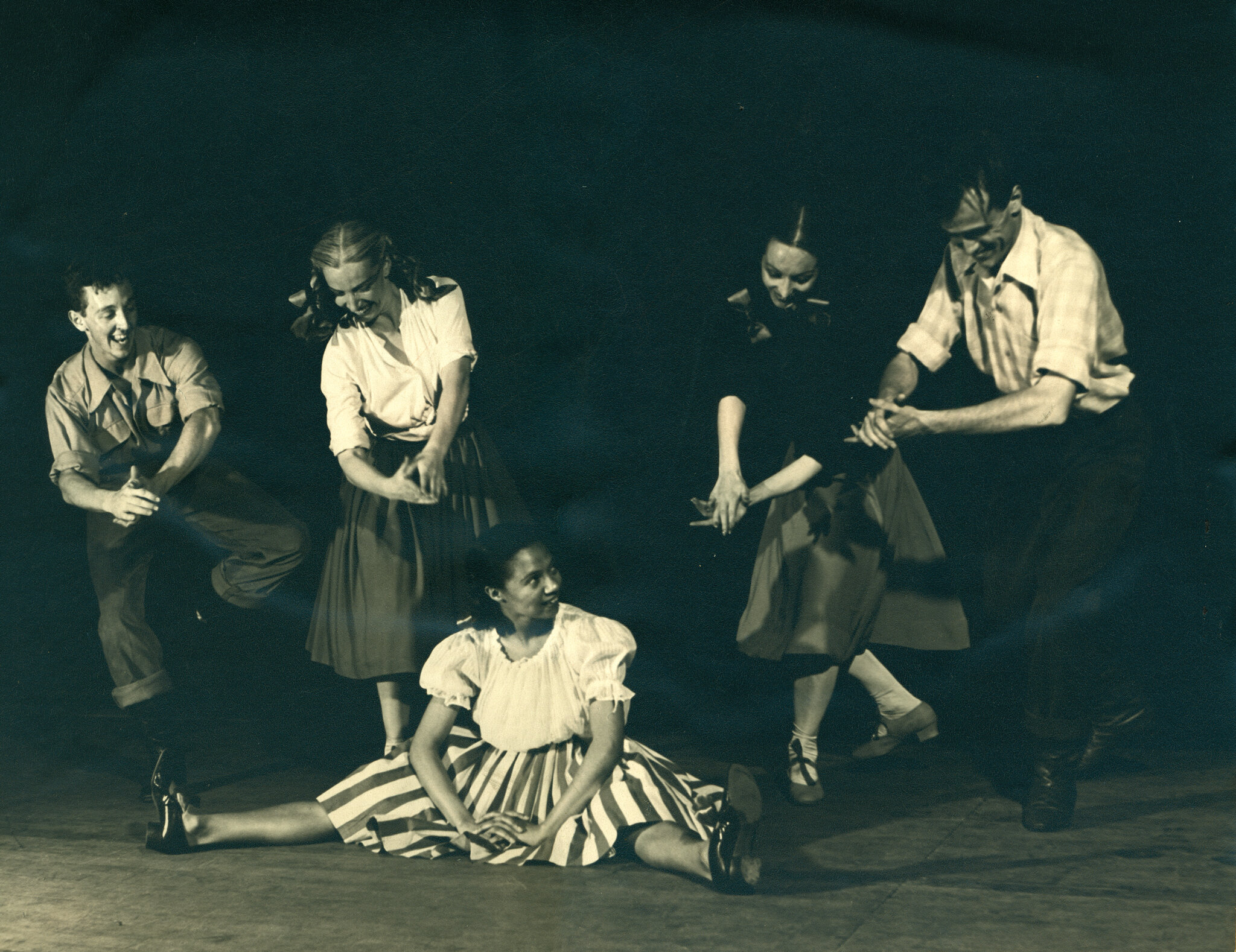
Don Gillies, Janet Baldwin, unknown (seated), Dorothy Dennenay and Bill Diver of the Volkoff Canadian Ballet, c. 1945 Jim Bolsby Portfolio, Dance Collection Danse
This image was donated to Dance Collection Danse in the 1980s. All white dancers were identified by the donor, Jim Bolsby. To date, no one has been able to confirm the identity of the Black woman in the seated position on the floor. Many indicators suggest that it is celebrated African-Canadian contralto singer Portia White, who performed in the same concerts as the Volkoff Canadian Ballet in the mid-1940s in Toronto. While programs in the DCD collection confirm these shared performances, there is no information to confirm that the costumes shown in the photo align with works listed in the programs. * In 2018, after years of discussion with Seika Boye, Portia White’s great-nephew, poet George Elliott Clarke felt secure in confirming the seated woman’s identity to be Portia White.
See Seika Boye’s article “Portia is that You: Contextualizing Doubt in Archival Research” (alt:theatre magazine 11.1)
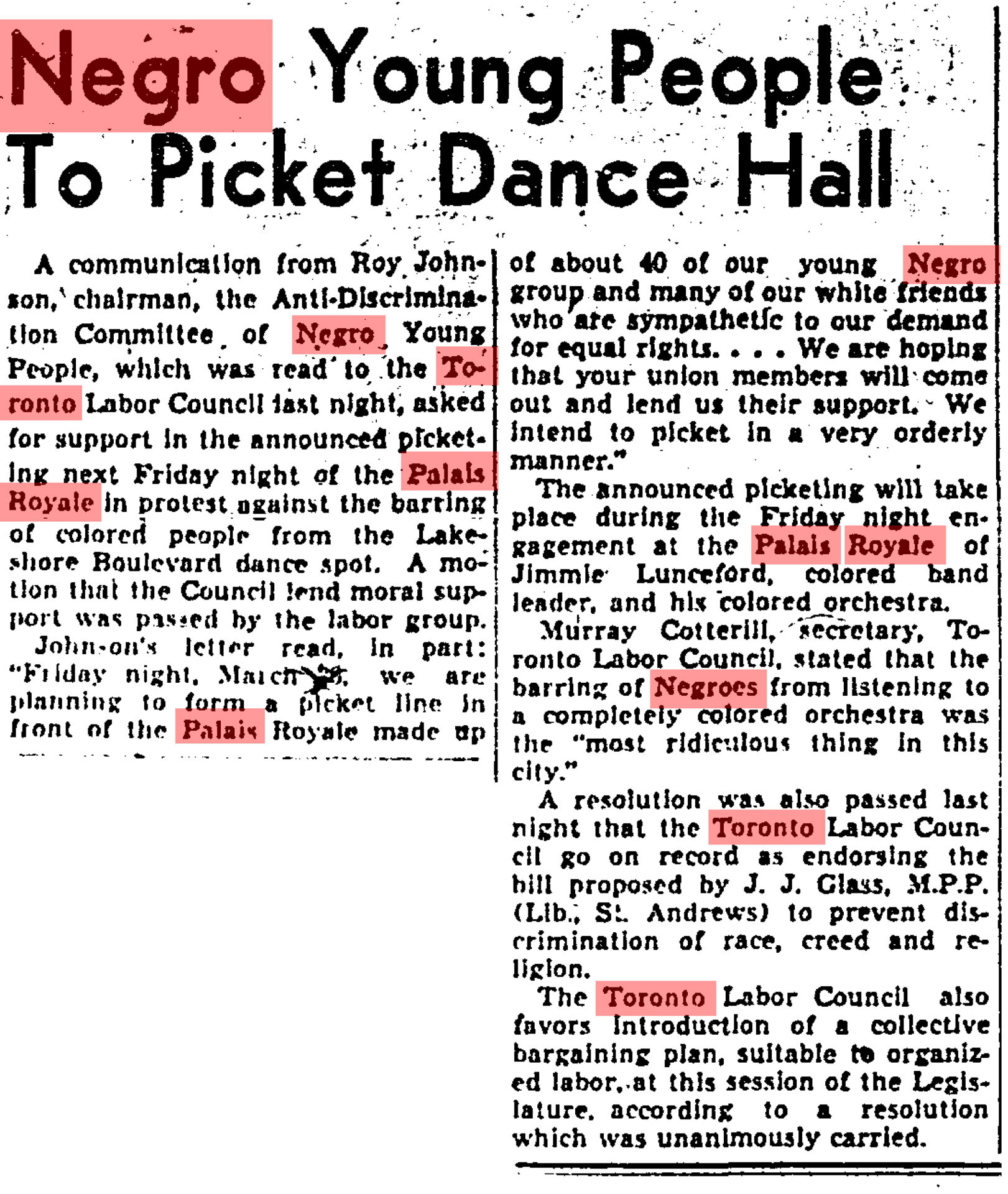
This selection of clippings demonstrates the variety of ways that Black people were denied entry to: dance and concert venues even when Black artists were on stage; dance classes when dance studios were teaching social dances derived from cultural practices of the African Diaspora; and social dance venues for participating in racialized dances such as the jive or jitterbug.
“Negro Young People to Picket Dance Hall.” The Globe and Mail. March 23, 1943.
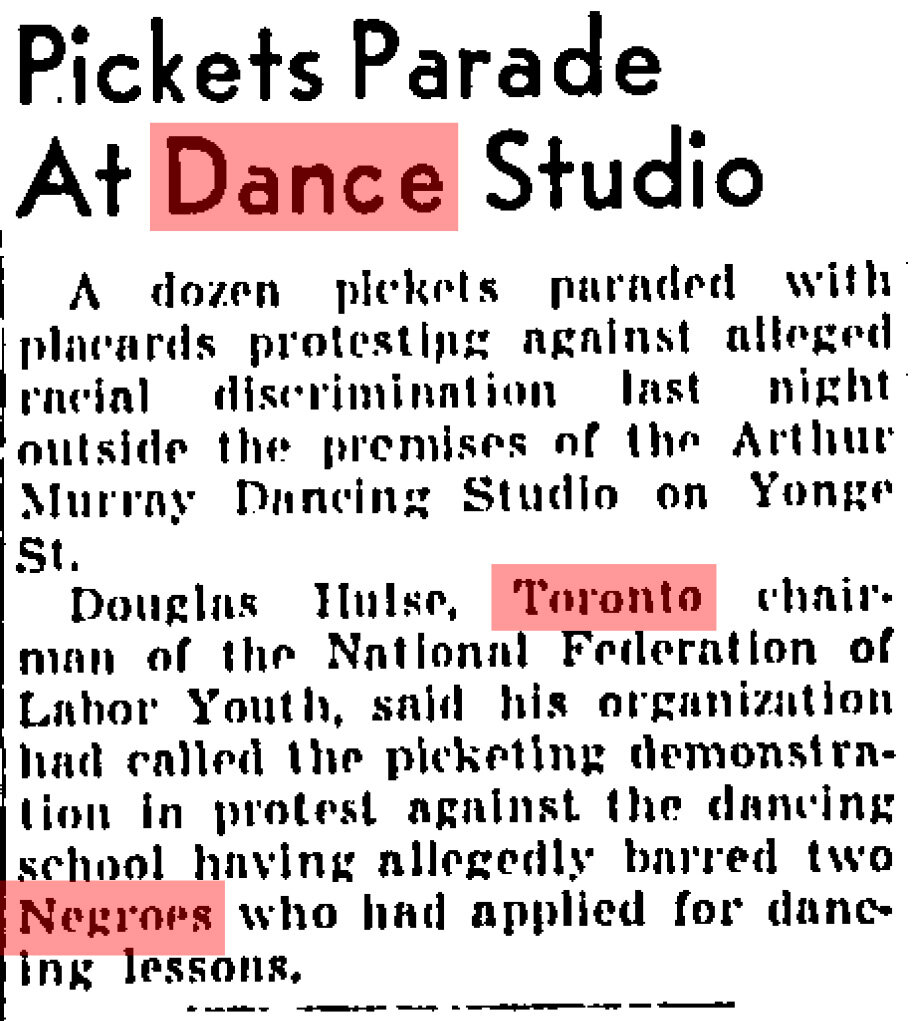
This selection of clippings demonstrates the variety of ways that Black people were denied entry to: dance and concert venues even when Black artists were on stage; dance classes when dance studios were teaching social dances derived from cultural practices of the African Diaspora; and social dance venues for participating in racialized dances such as the jive or jitterbug.
“Pickets Parade at Dance Studio.” The Globe and Mail. March 20, 1947.
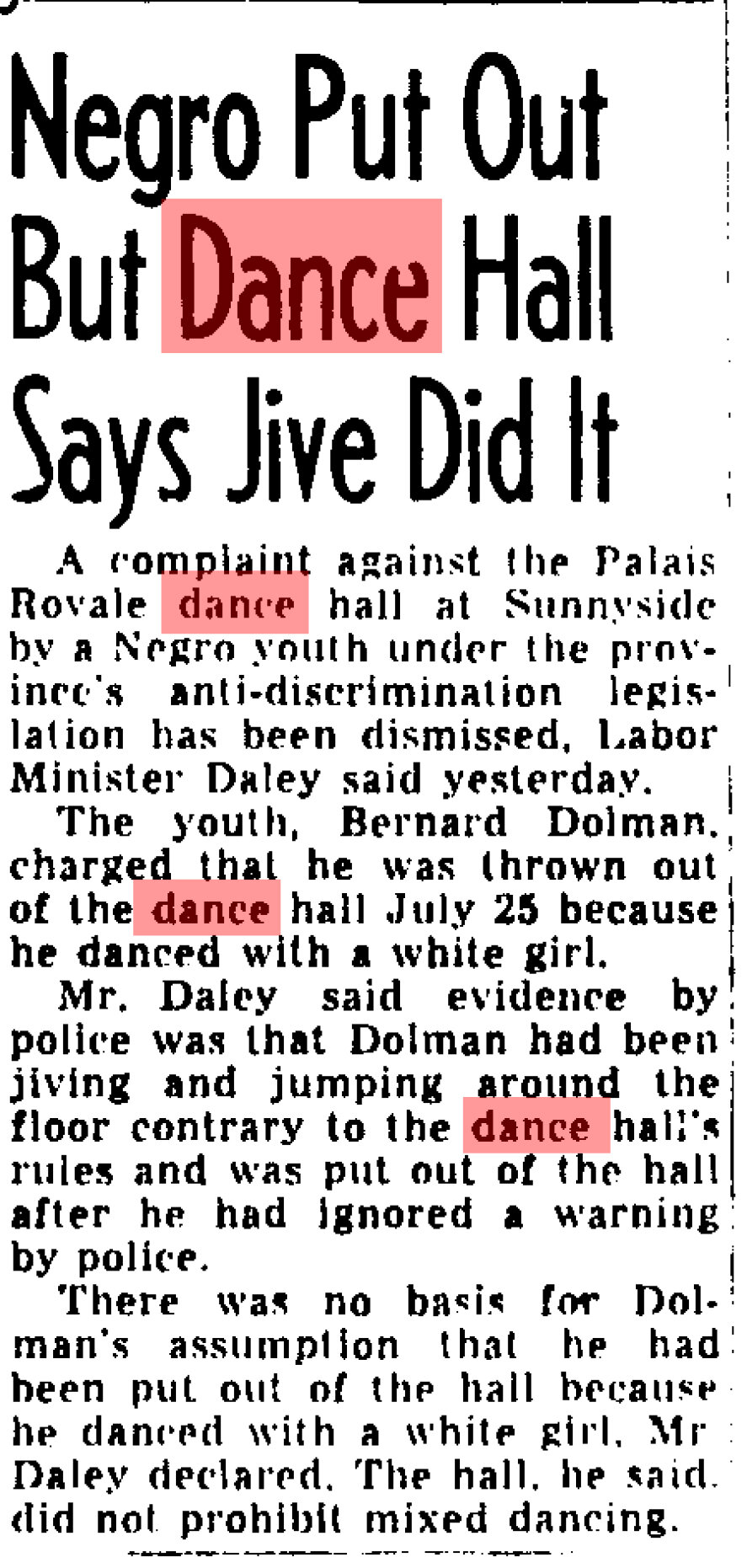
This selection of clippings demonstrates the variety of ways that Black people were denied entry to: dance and concert venues even when Black artists were on stage; dance classes when dance studios were teaching social dances derived from cultural practices of the African Diaspora; and social dance venues for participating in racialized dances such as the jive or jitterbug.
“Negro Put Out Dance Hall Says Jive Did It.” The Globe and Mail. August 19, 1955.
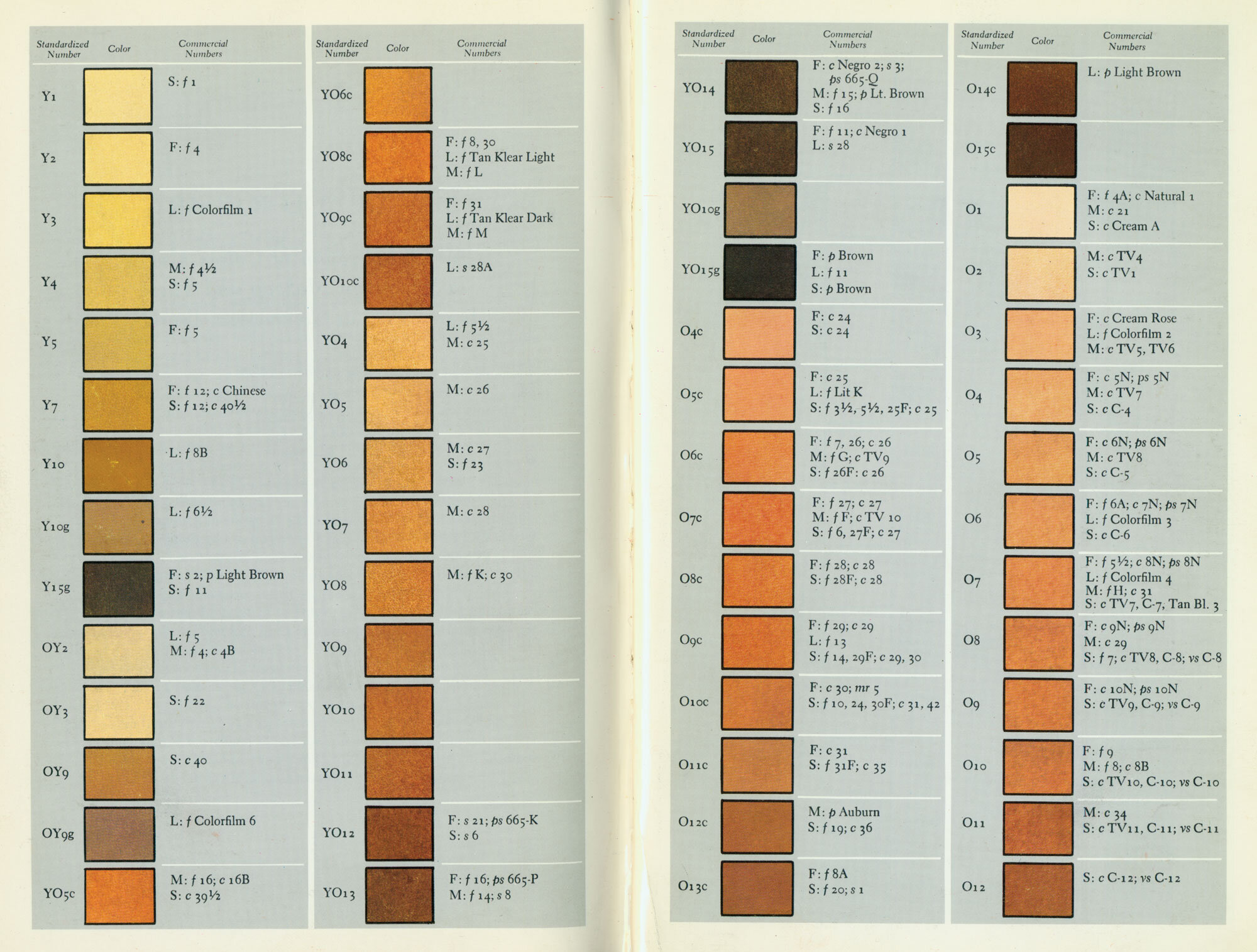
Colour palette guide for mixing make-up to achieve “accurate”, “ethnic” complexions
Reproduction from Stage Make-up , 4th edition by Richard Corson (Appleton-Century-Crofts Education Division, New York, 1970 ed. from original publication in 1942).
On loan from the personal collection of Seika Boye
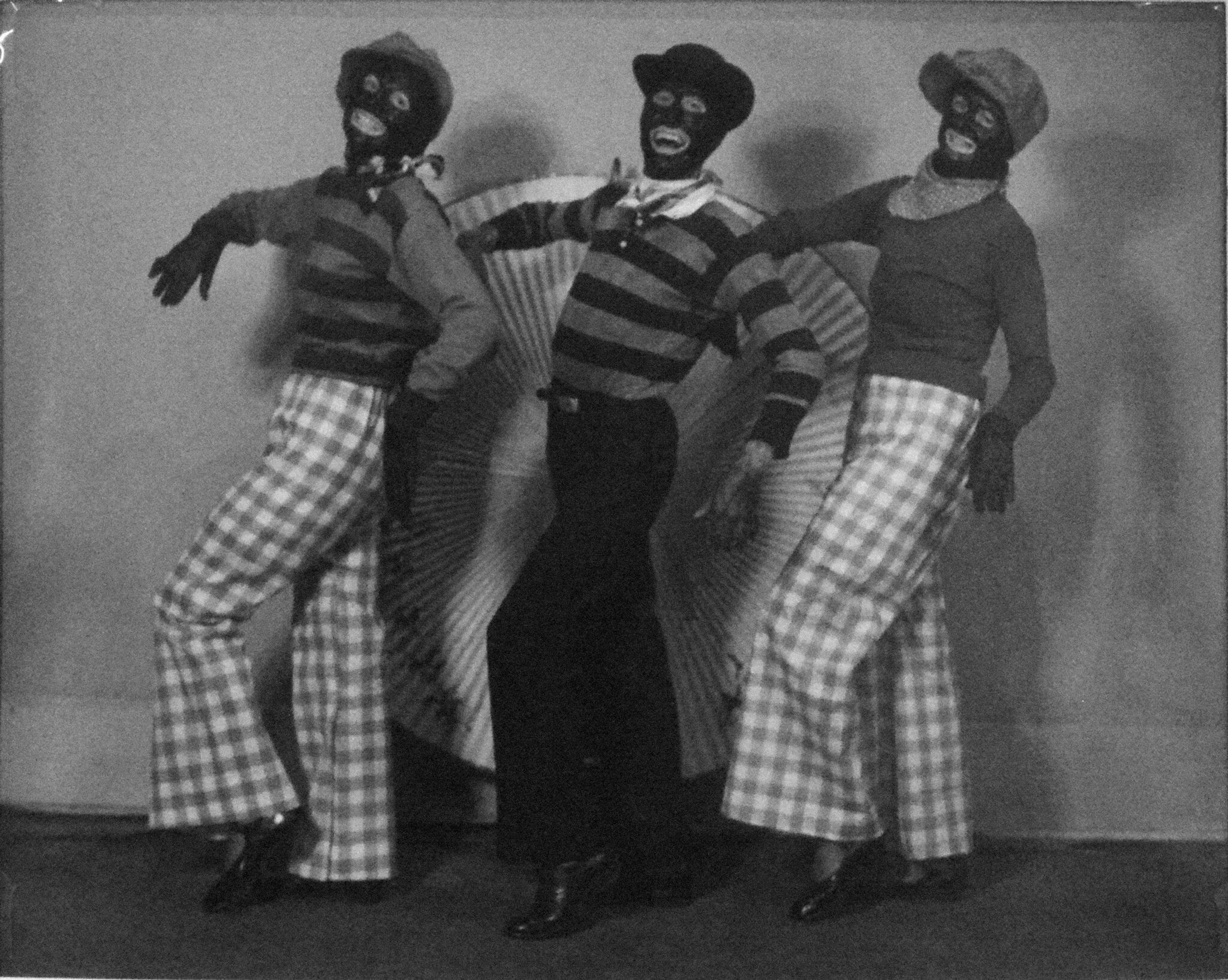
Florence Clough dancers in blackface
Dancers in Blackface for a recital by the Florence Clough Dance Studio, Victoria,British Columbia, 1920s.
On loan from the South Vancouver Island Dance Archives, Florence Clough Collection, 006-2014-2-3.
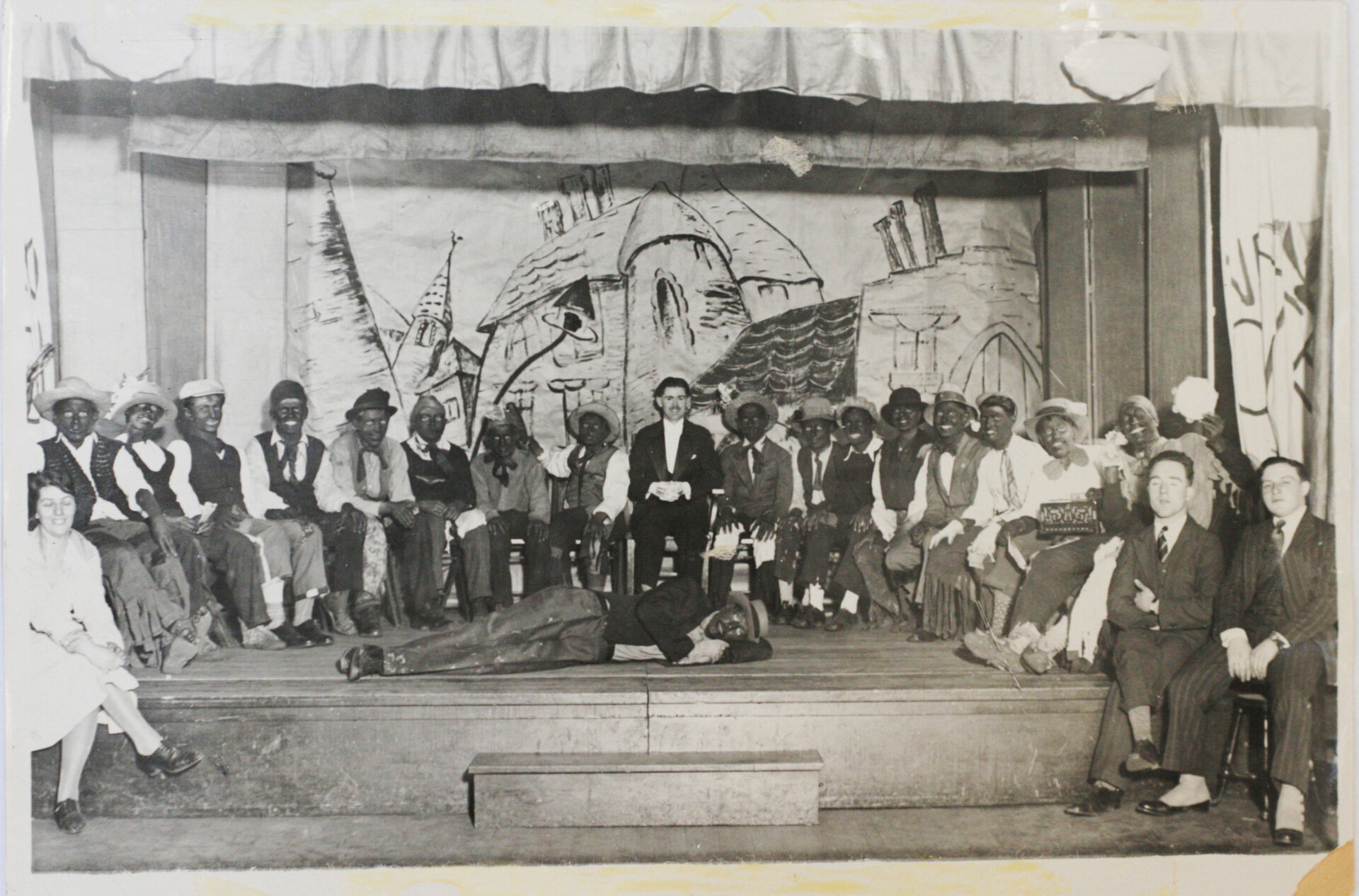
Theatrical players in Blackface, 1930
Theatrical players in Blackface, 1930
Reproduction of Image 20N, Box 1, Series 1024, University Settlement House Fonds, courtesy of City of Toronto Archives.
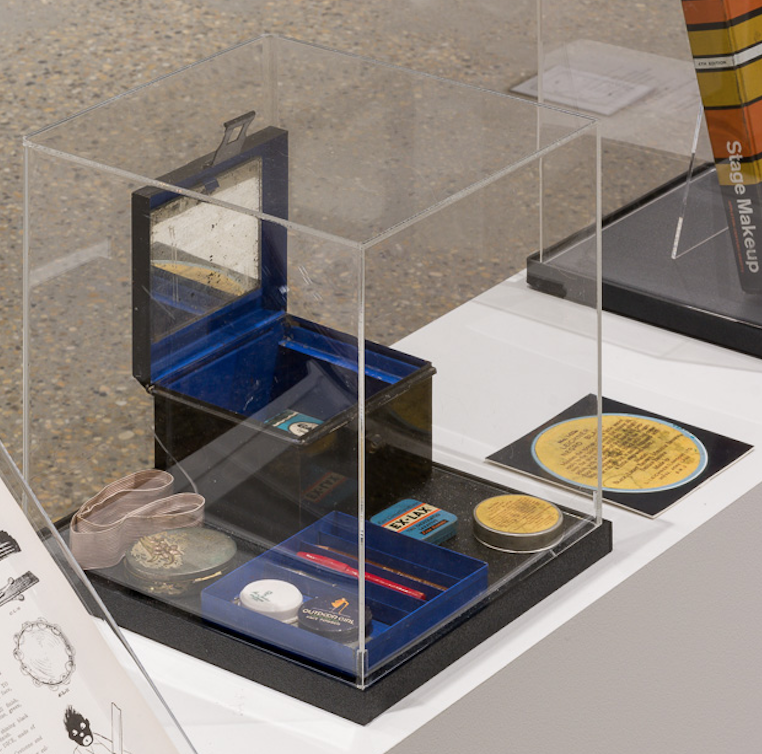
Make-up case and various items of stage make-up
Make-up case and various items of stage make-up
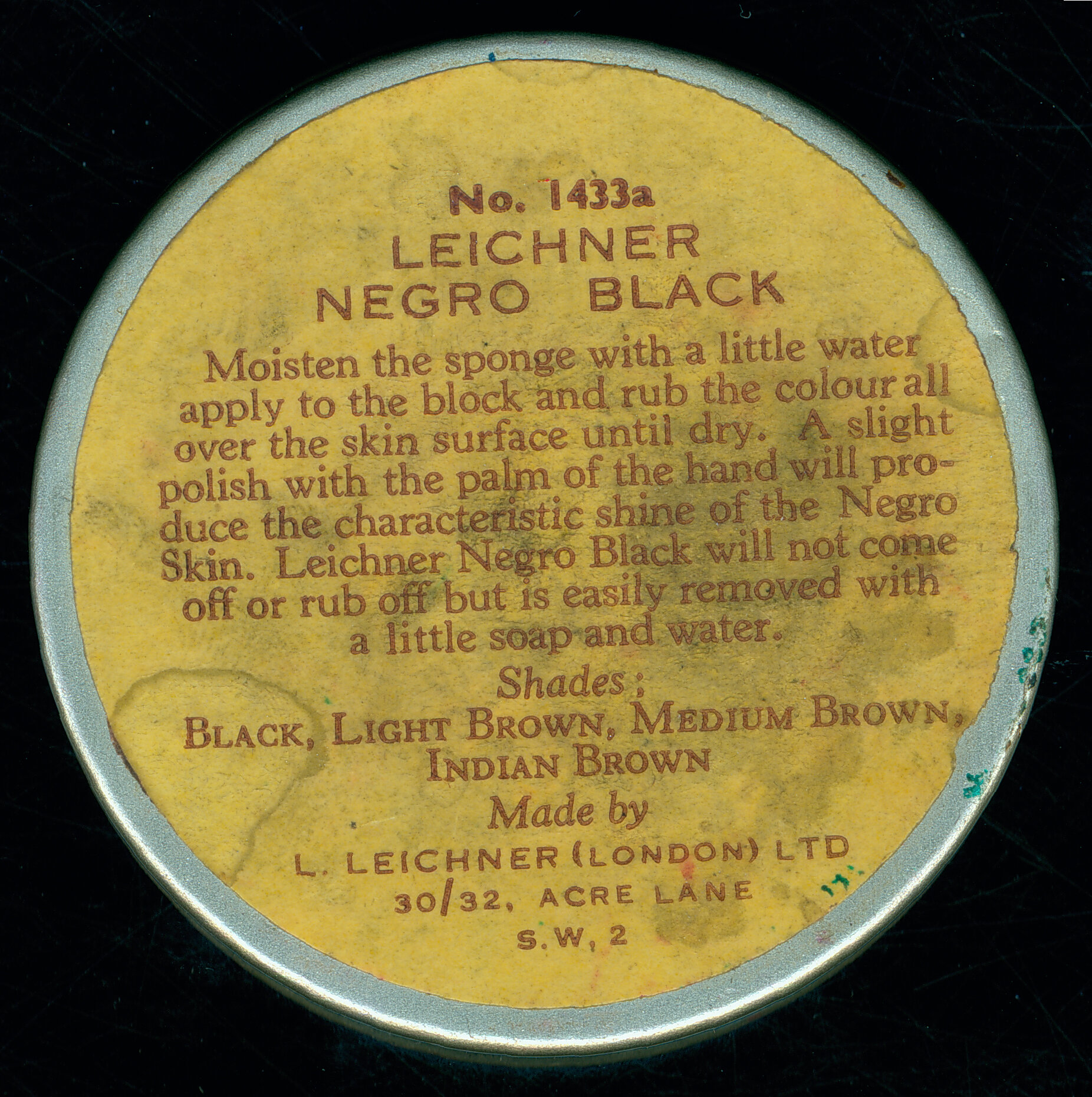
Make-up case and various items of stage make-up
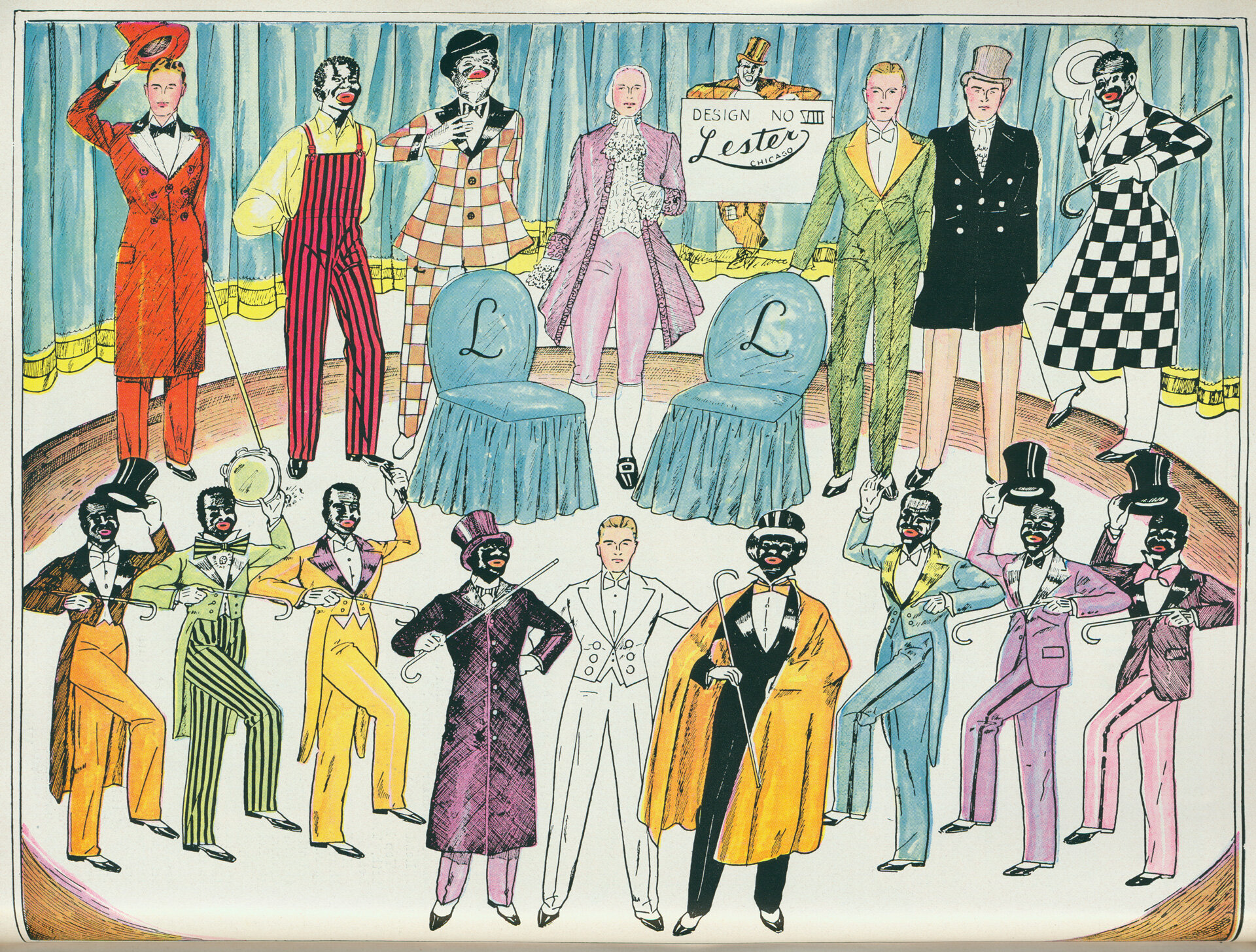
Page excerpt from Lester Ltd.'s Distinctive Costume Designs catalogue, Chicago, 1935
Page excerpt from Lester Ltd.’s Distinctive Costume Designs catalogue, Chicago, 1935
Reproduction, Flea Market Collection, Dance Collection Danse.
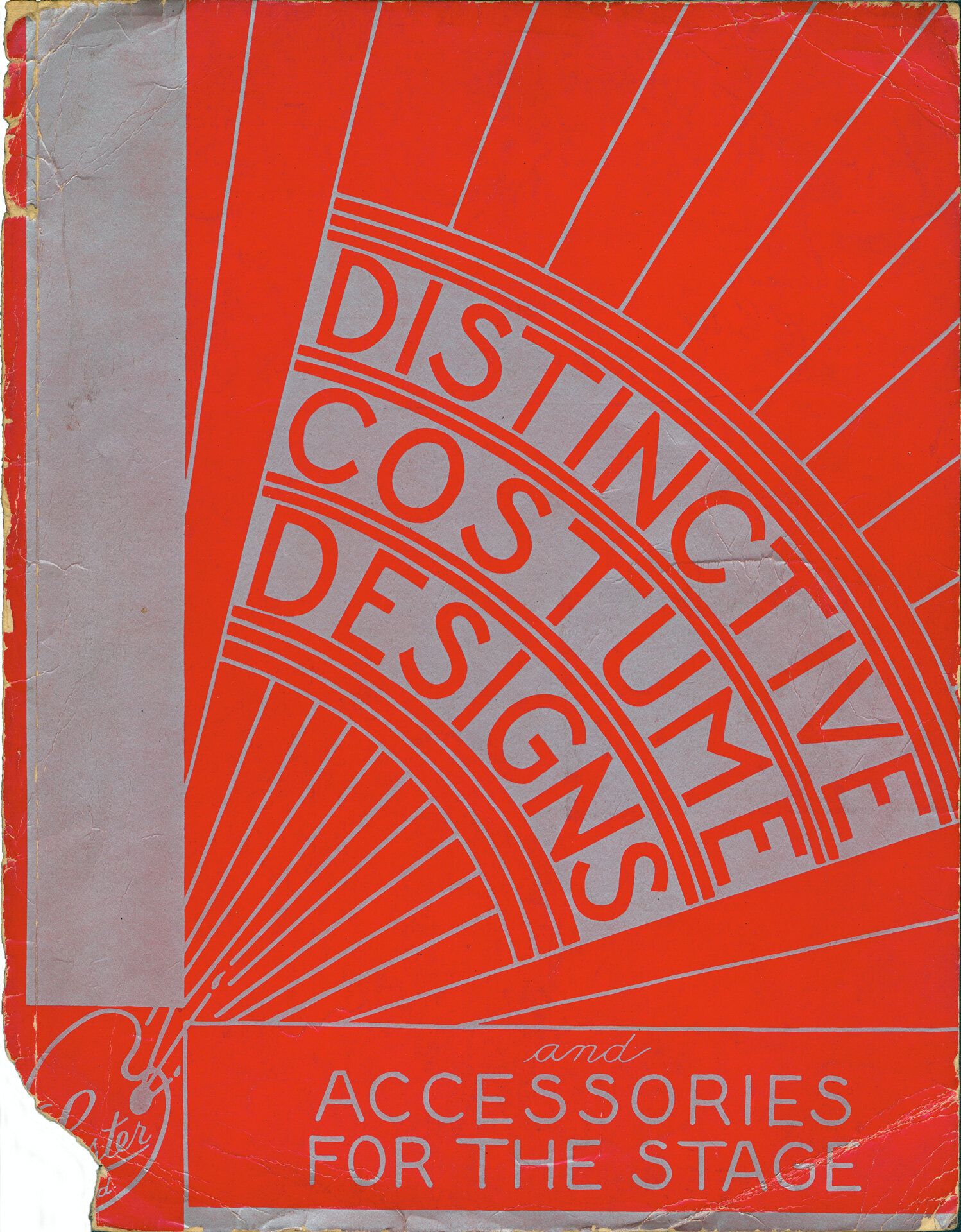
Cover of Lester Ltd.'s Distinctive Costume Designs catalogue, Chicago, 1935
Cover of Lester Ltd.’s Distinctive Costume Designs catalogue, Chicago, 1935.
Reproduction, Flea Market Collection, Dance Collection Danse.
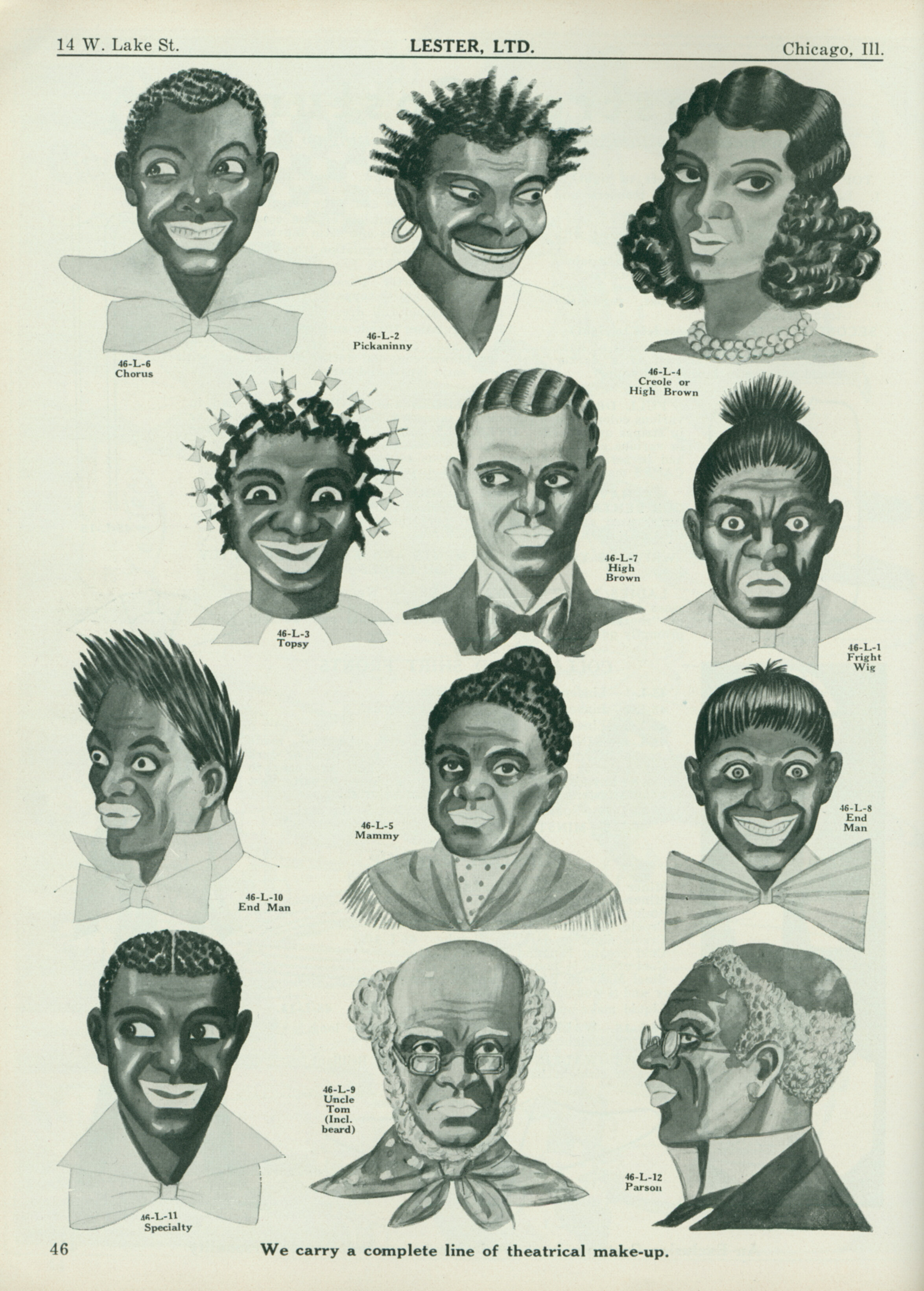
Lester Ltd.'s Distinctive Costume Design catalogue, Chicago, 1935
Lester Ltd.’s Distinctive Costume Designs catalogue, Chicago, 1935 Flea Market Collection, Dance Collection Danse
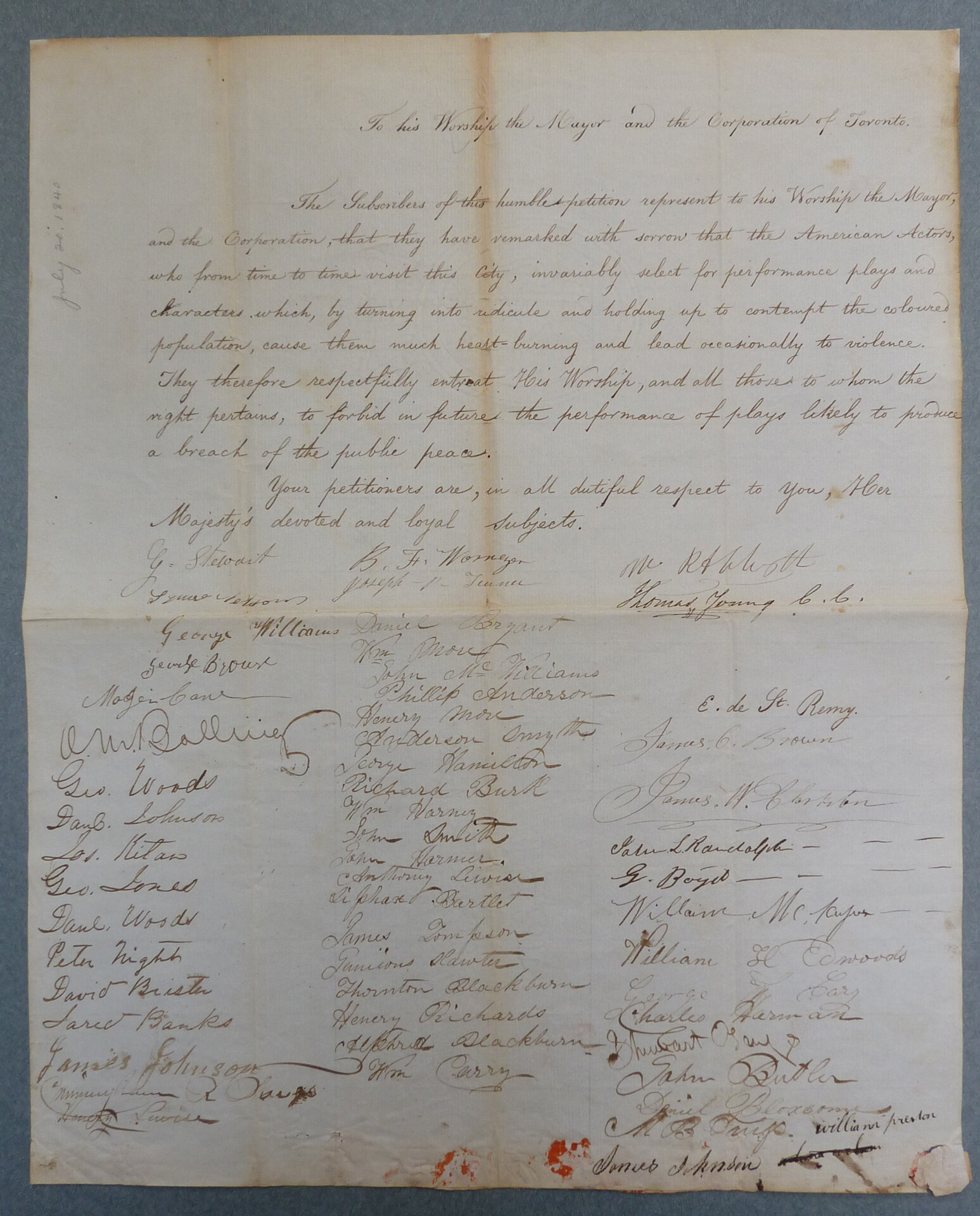
Petition, July 20, 1840
Petition, July 20, 1840, stating:
To his Worship the Mayor and the Corporation of Toronto. The subscribers of this humble petition represent to his Worship the Mayor, and the Corporation, that they have remarked with sorrow that the American Actors, who from time to time visit this City, invariably select for performance plays and characters which, by turning into ridicule and holding up to contempt the coloured population, cause them much heart-burning and lead occasionally to violence. They therefore respectfully entreat His Worship, and all those to whom the right pertains, to forbid in future the performance of plays likely to produce a breach of the public peace.
Your petitioners are, in all dutiful respect to you, Her Majesty’s devoted and loyal subjects.
Reproduction of item 605, Series 1081, Fonds 200, courtesy of City of Toronto Archives
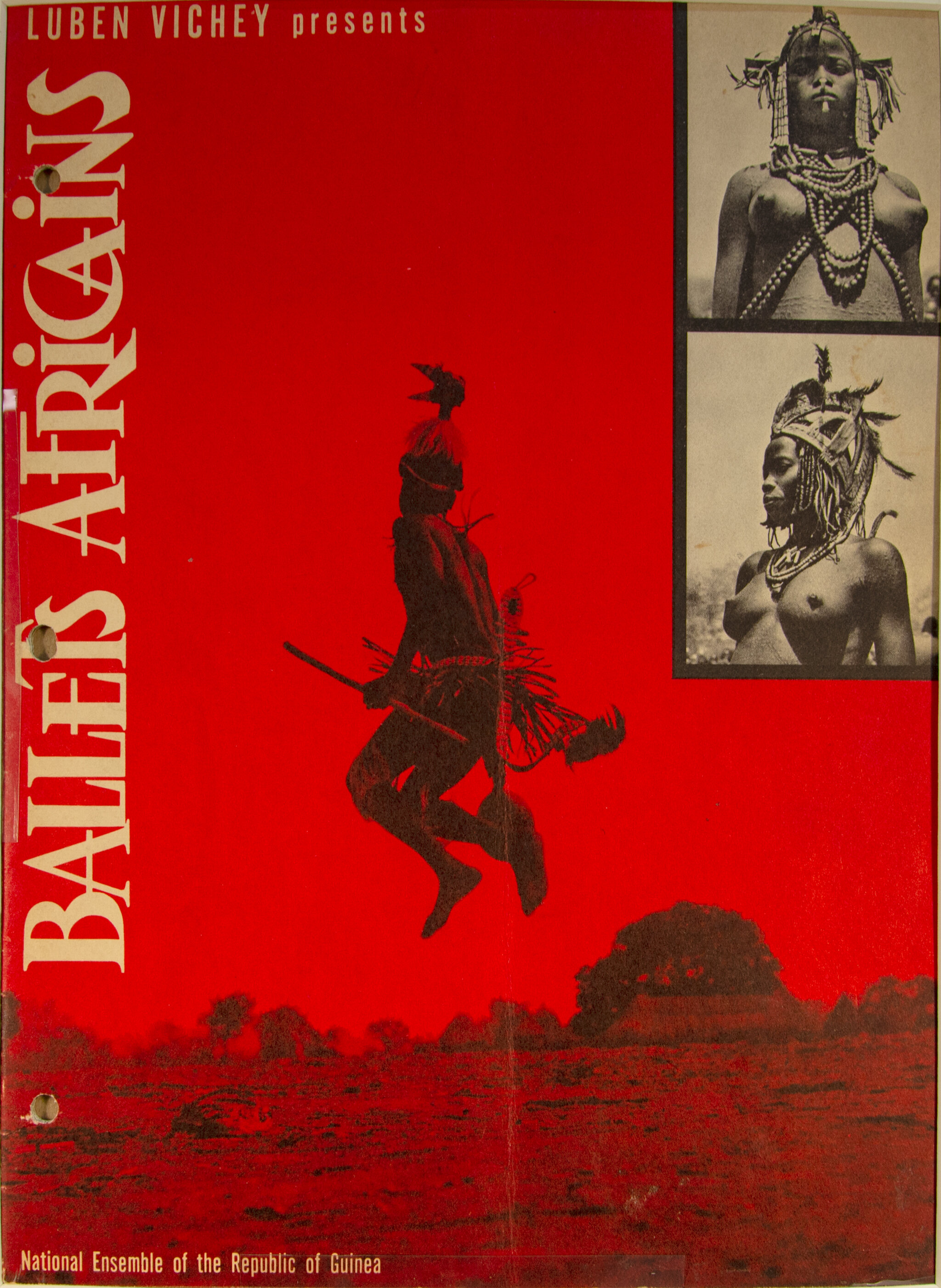
Les Ballets Africains cover
Les Ballets Africains Souvenir Program, 1959
Flea Market Collection, Dance Collection Danse.
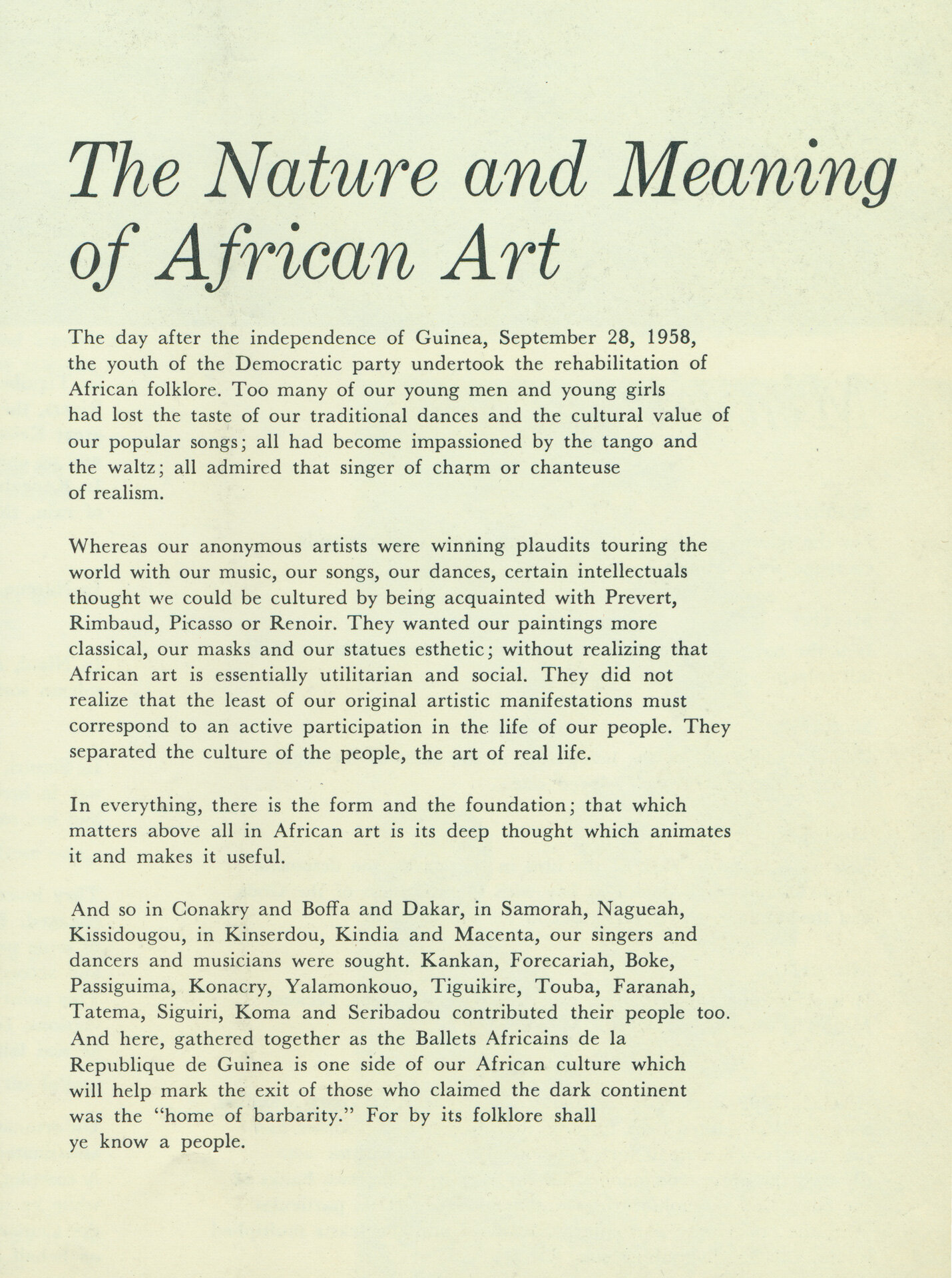
Image from Les Ballets Africains souvenir program, 1959.
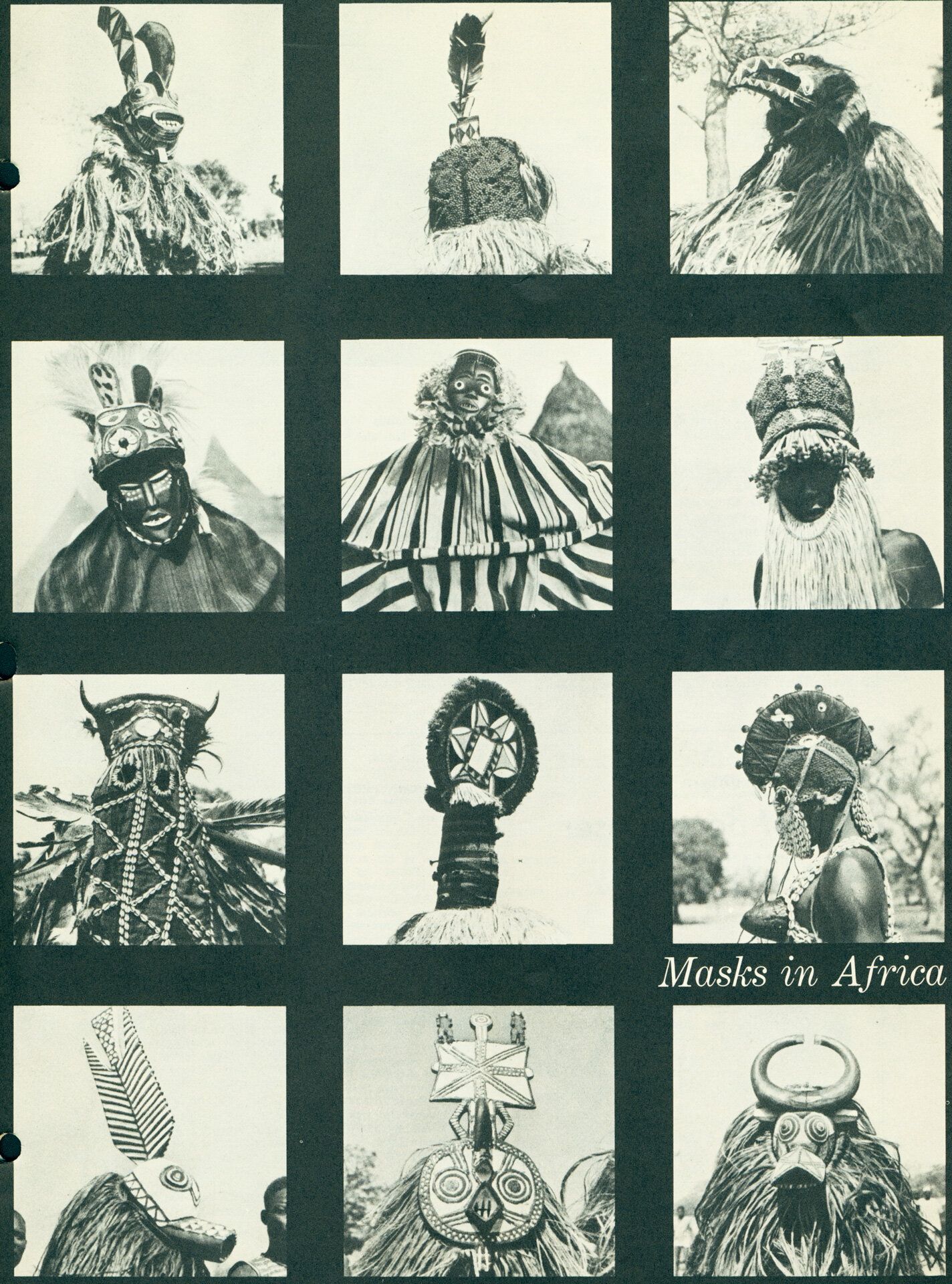
Image from Les Ballets Africains souvenir program, 1959.
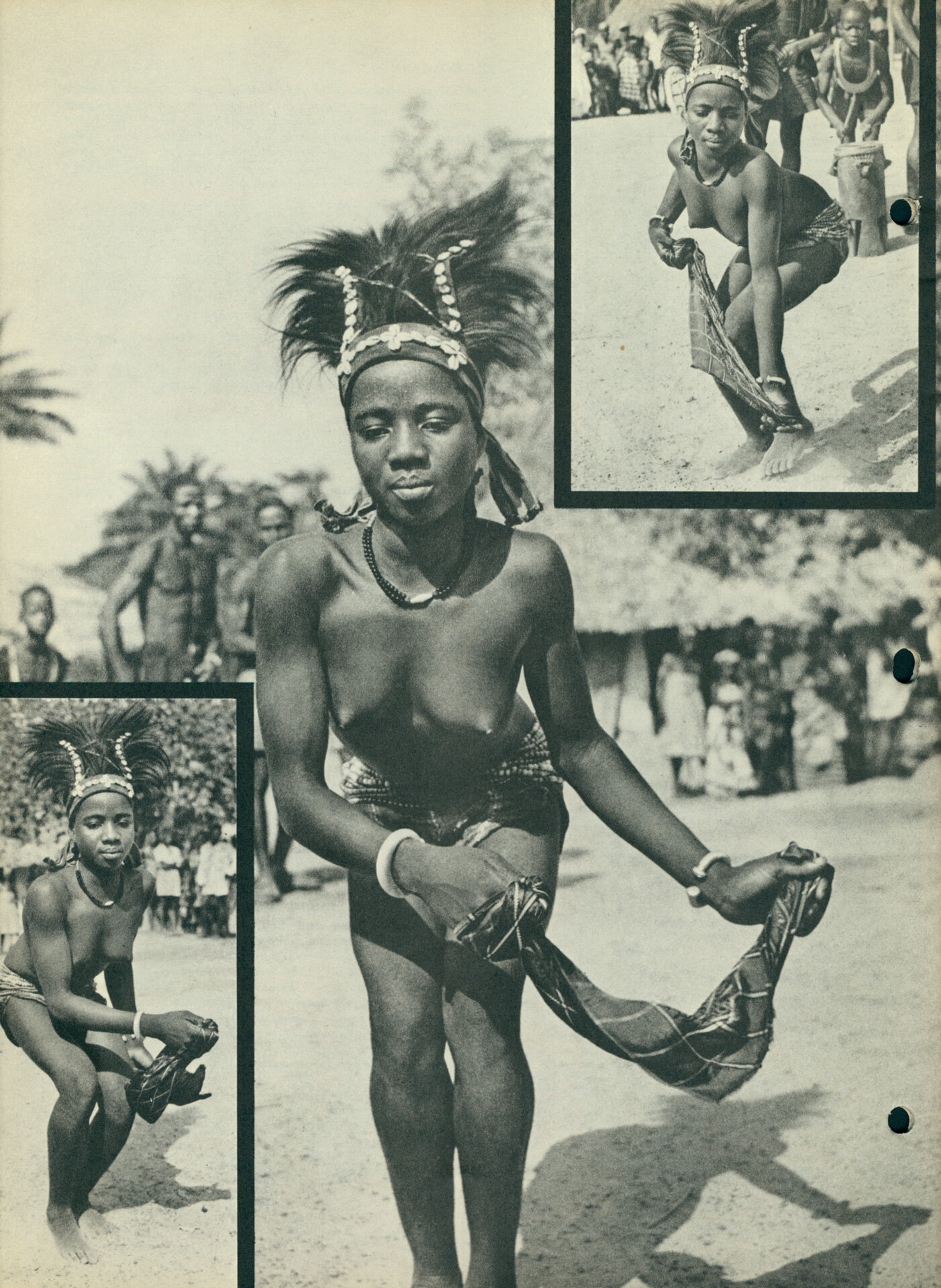
Image from Les Ballets Africains souvenir program, 1959.
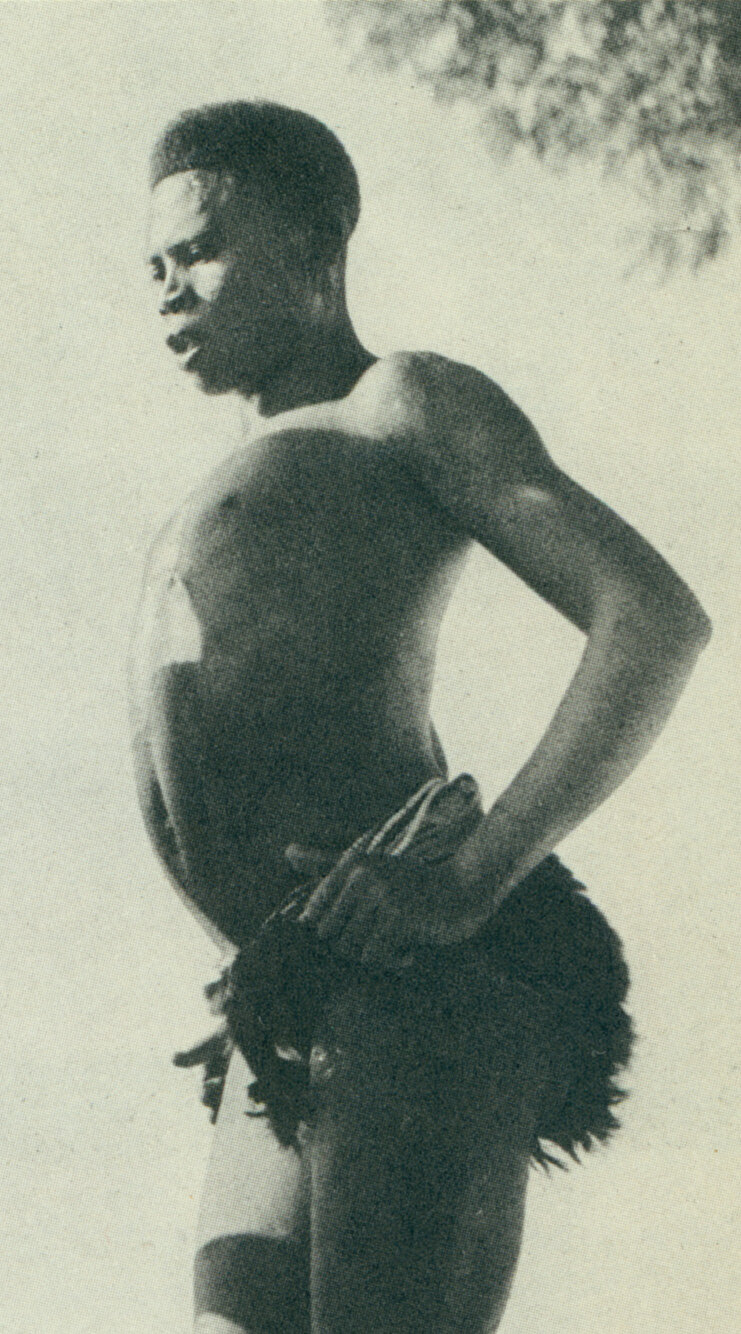
Image from Les Ballets Africains souvenir program, 1959.
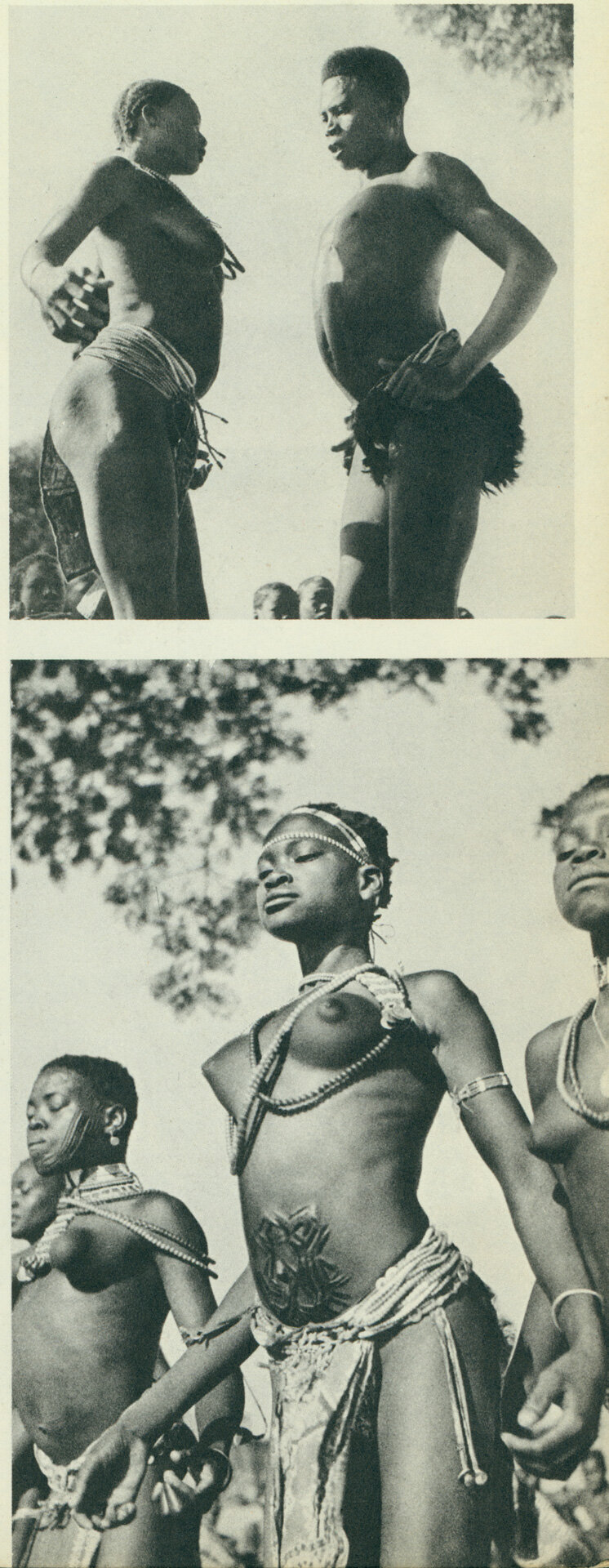
Image from Les Ballets Africains souvenir program, 1959.
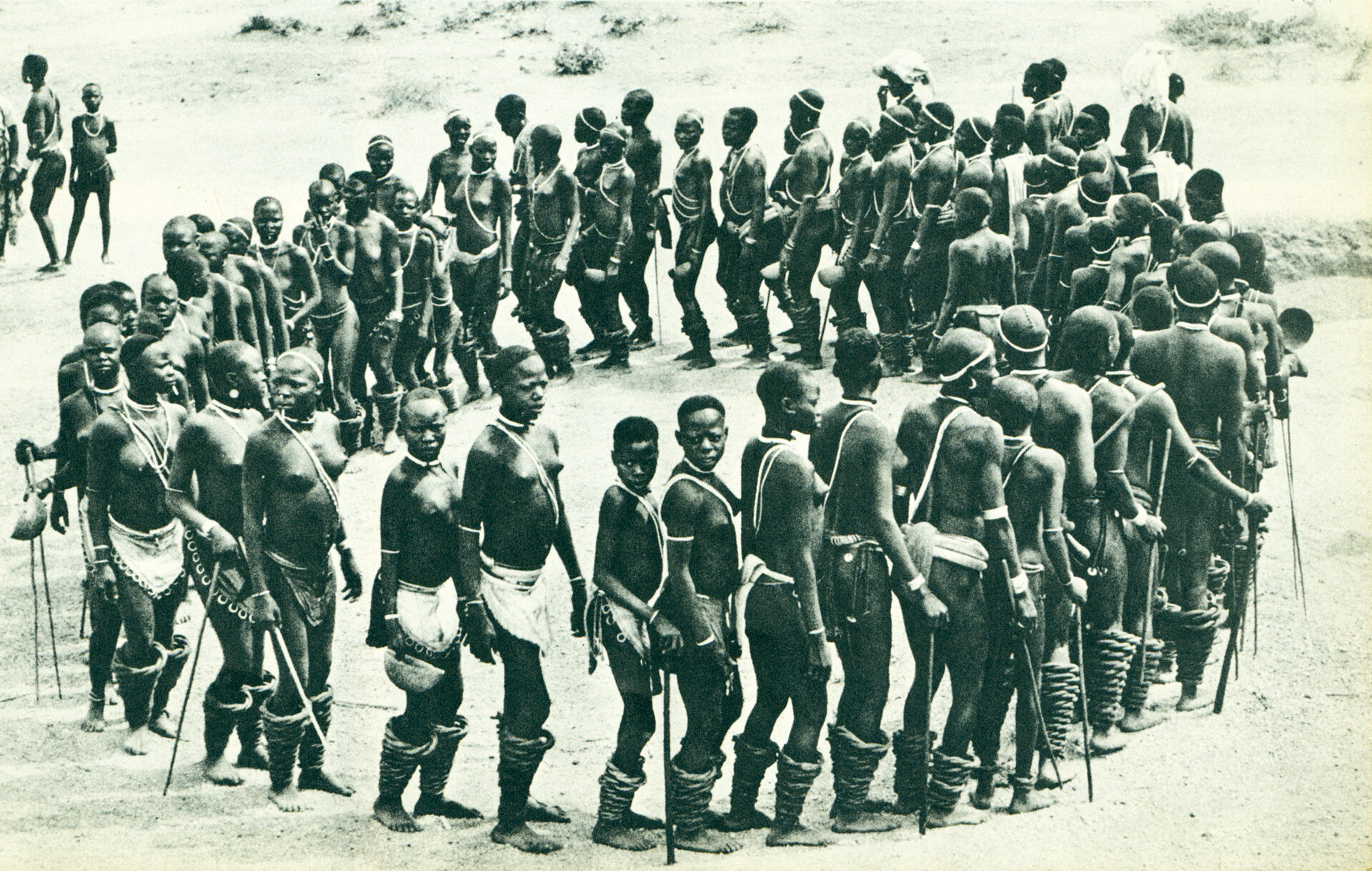
Image from Les Ballets Africains souvenir program, 1959.
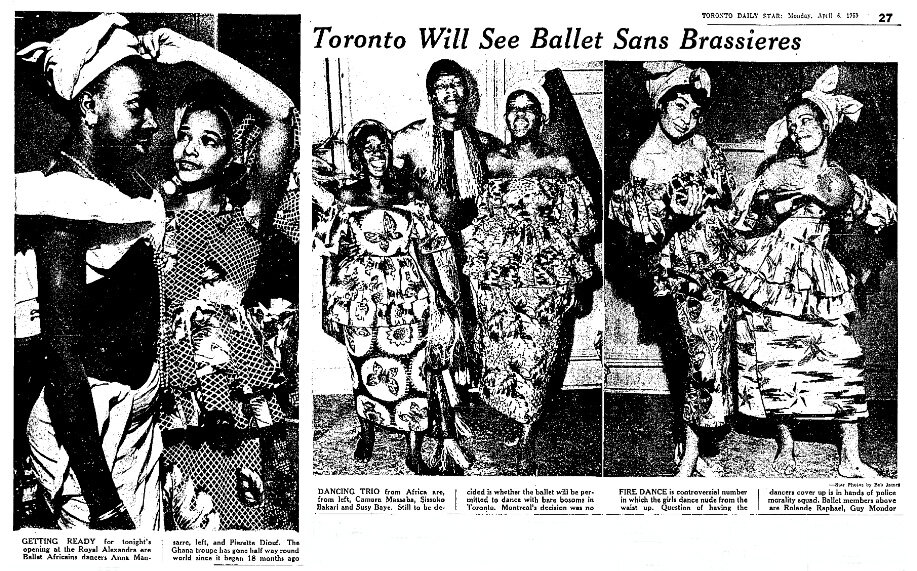
Reproductions of a selection of articles from the mainstream press including the Toronto Daily Star and the Globe and Mail , March and April 1959.
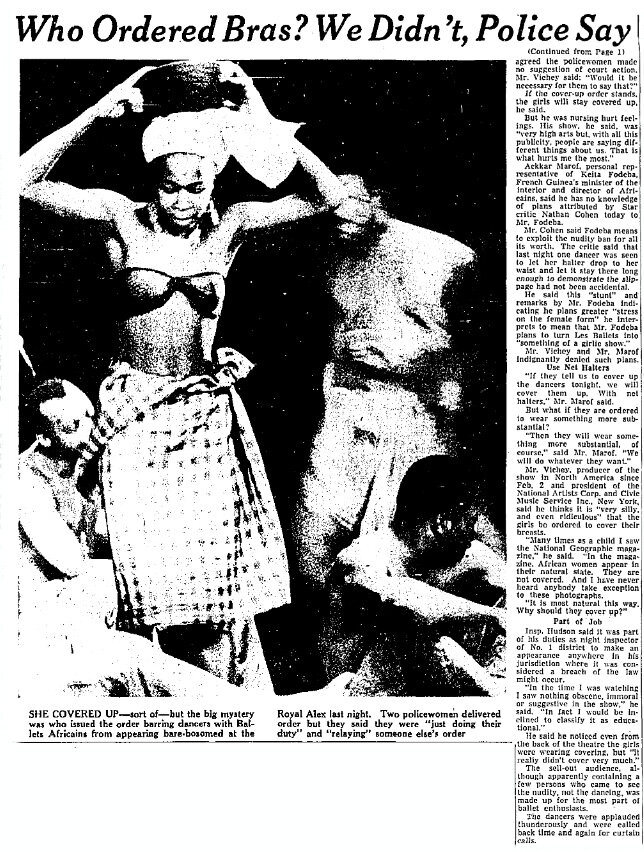
Reproductions of a selection of articles from the mainstream press including the Toronto Daily Star and the Globe and Mail , March and April 1959.
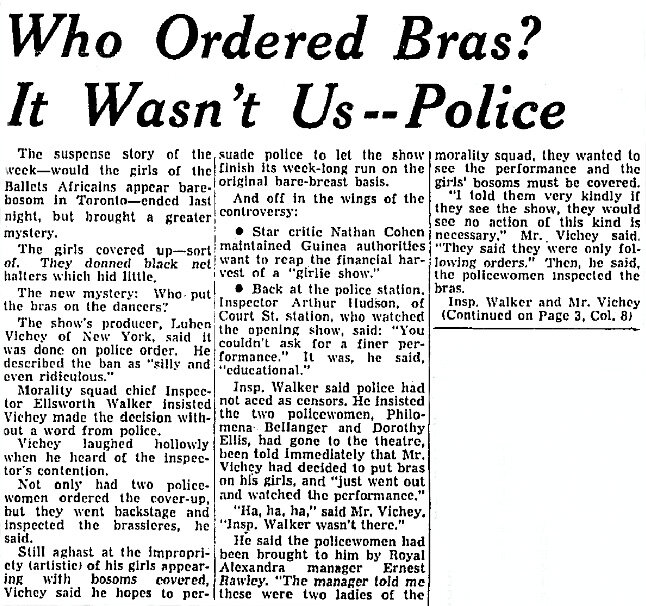
Reproductions of a selection of articles from the mainstream press including the Toronto Daily Star and the Globe and Mail , March and April 1959.
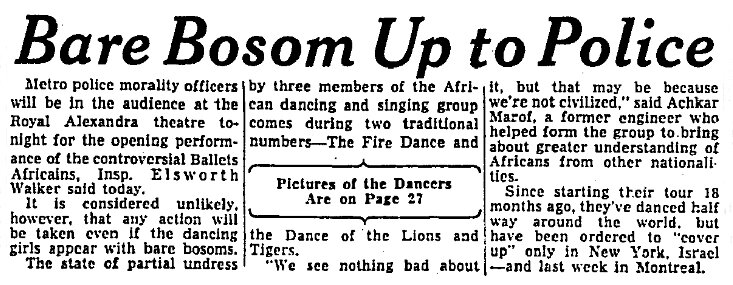
Reproductions of a selection of articles from the mainstream press including the Toronto Daily Star and the Globe and Mail , March and April 1959.

Reproductions of a selection of articles from the mainstream press including the Toronto Daily Star and the Globe and Mail , March and April 1959.
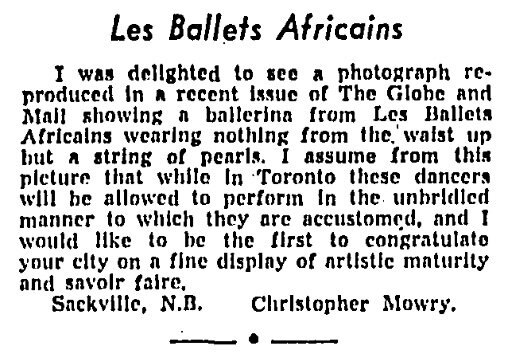
Reproductions of a selection of articles from the mainstream press including the Toronto Daily Star and the Globe and Mail , March and April 1959.
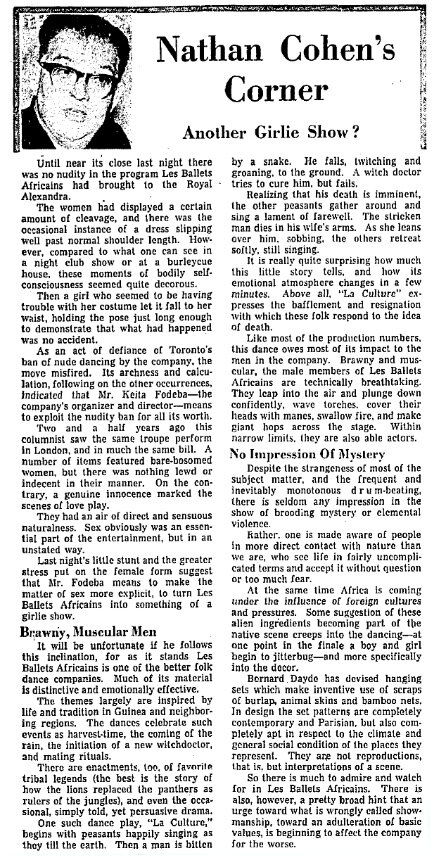
Reproductions of a selection of articles from the mainstream press including the Toronto Daily Star and the Globe and Mail , March and April 1959.
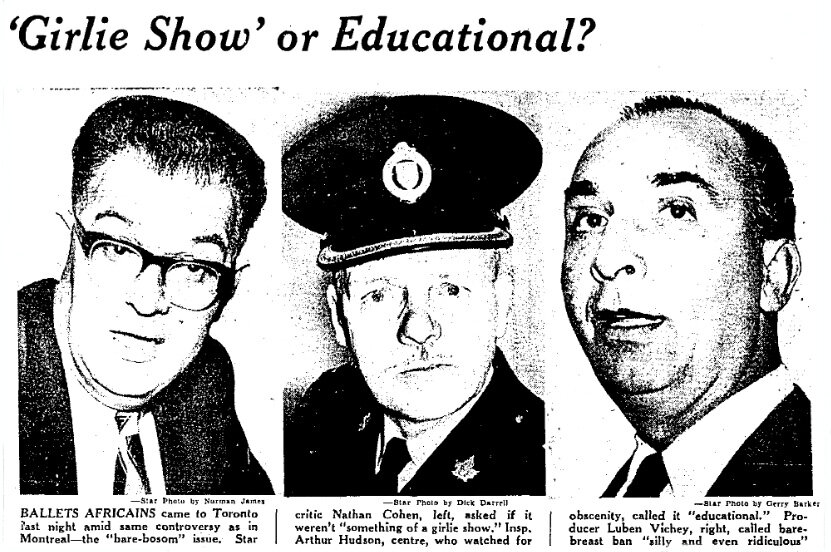
Reproductions of a selection of articles from the mainstream press including the Toronto Daily Star and the Globe and Mail , March and April 1959.
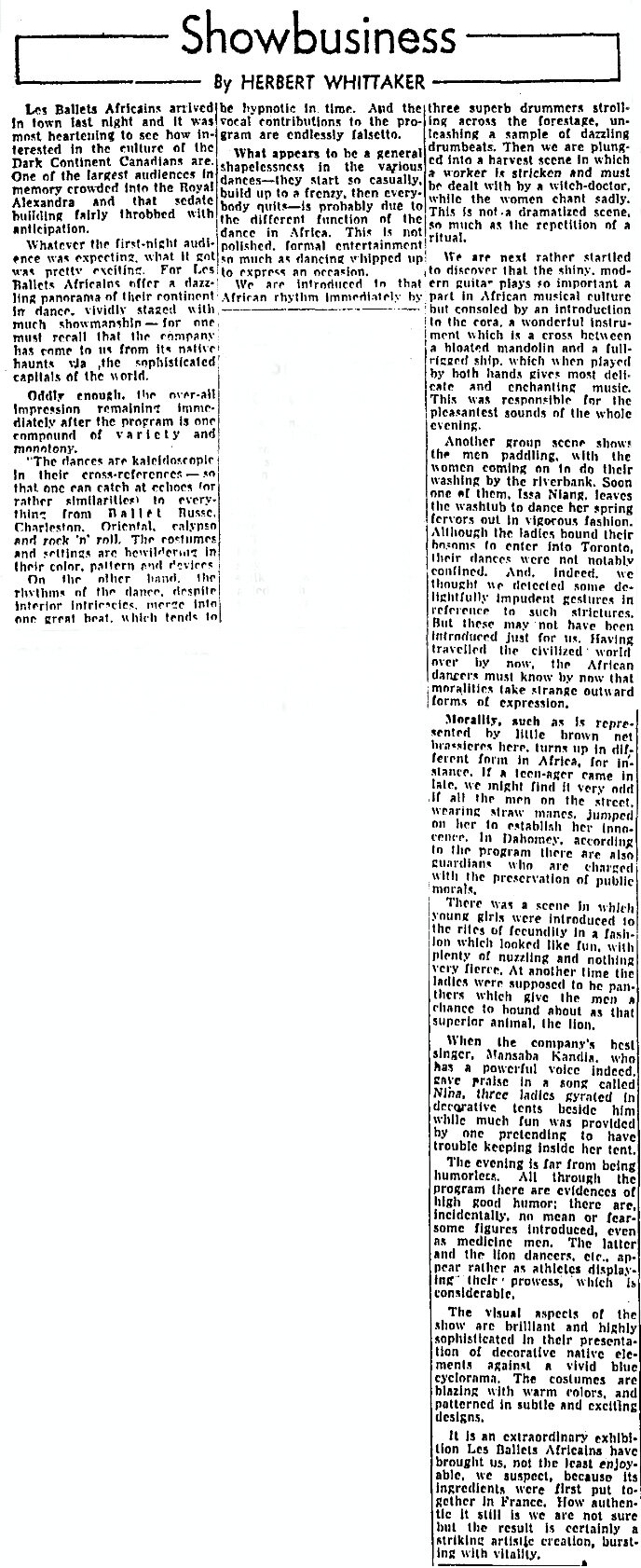
Reproductions of a selection of articles from the mainstream press including the Toronto Daily Star and the Globe and Mail , March and April 1959.

Reproductions of a selection of articles from the mainstream press including the Toronto Daily Star and the Globe and Mail , March and April 1959.
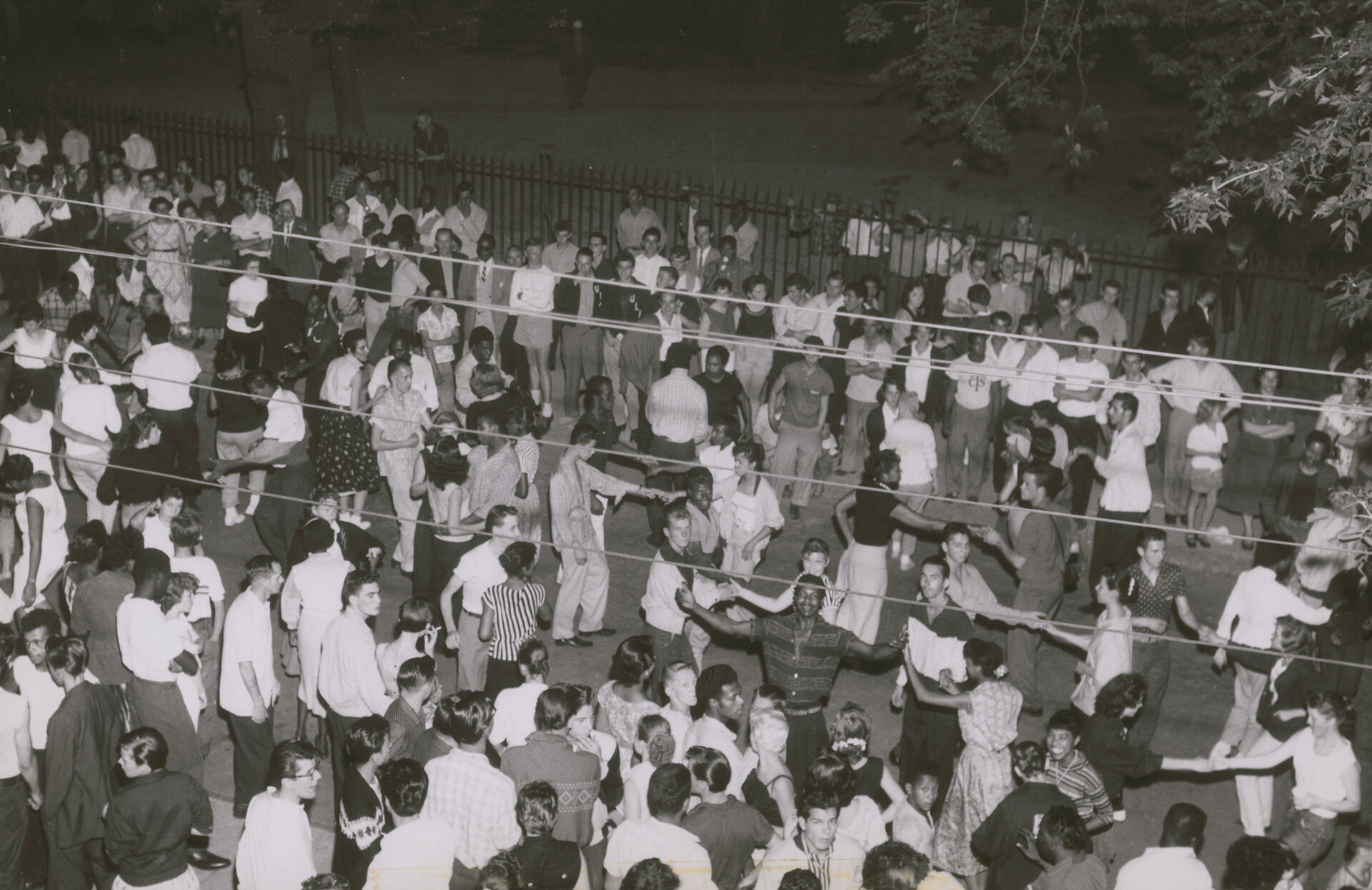
“Grange Road Dances 1956” appeared in the Globe and Mail on August 9, 1956
Photos: Harry McLorinan (staff photographer for Globe). Public Domain. Reproductions provided courtesy of City of Toronto Archives (University Settlement House Fonds 1024, Series 709, Box 1, Image 20N) Images from social dances, house parties, concerts and recitals are a potential source for positive images of Canada’s Black population, especially of young people, in the early to mid twentieth-century.

Image from “Grange Road Dances 1956”, Globe and Mail on August 9, 1956.
Photos: Harry McLorinan (staff photographer for Globe). Public Domain. Reproductions provided courtesy of City of Toronto Archives (University Settlement House Fonds 1024, Series 709, Box 1, Image 20N).
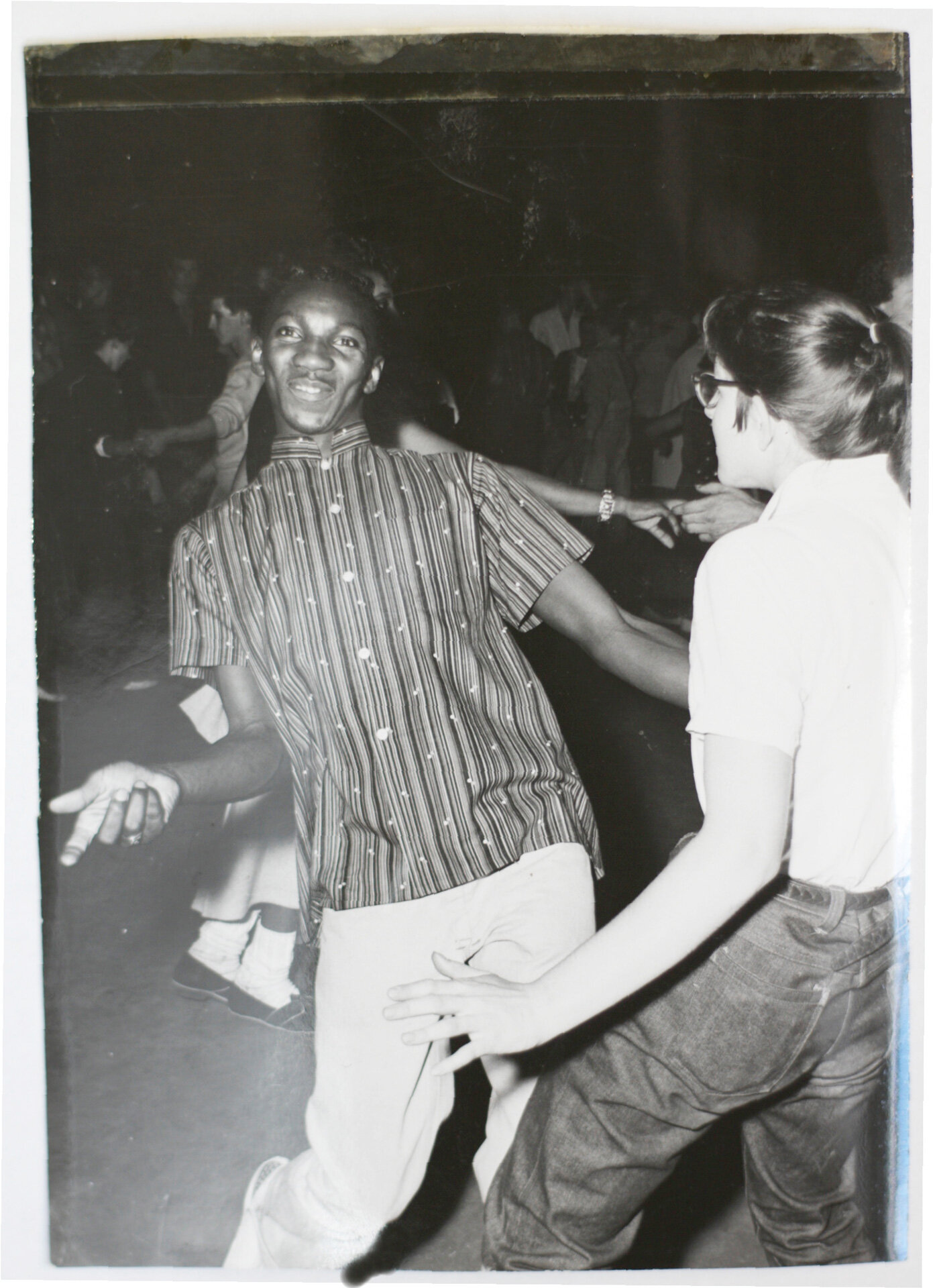
Image from “Grange Road Dances 1956”, Globe and Mail on August 9, 1956.
Photos: Harry McLorinan (staff photographer for Globe). Public Domain. Reproductions provided courtesy of City of Toronto Archives (University Settlement House Fonds 1024, Series 709, Box 1, Image 20N).

Image from “Grange Road Dances 1956”, Globe and Mail on August 9, 1956.
Photos: Harry McLorinan (staff photographer for Globe). Public Domain. Reproductions provided courtesy of City of Toronto Archives (University Settlement House Fonds 1024, Series 709, Box 1, Image 20N).
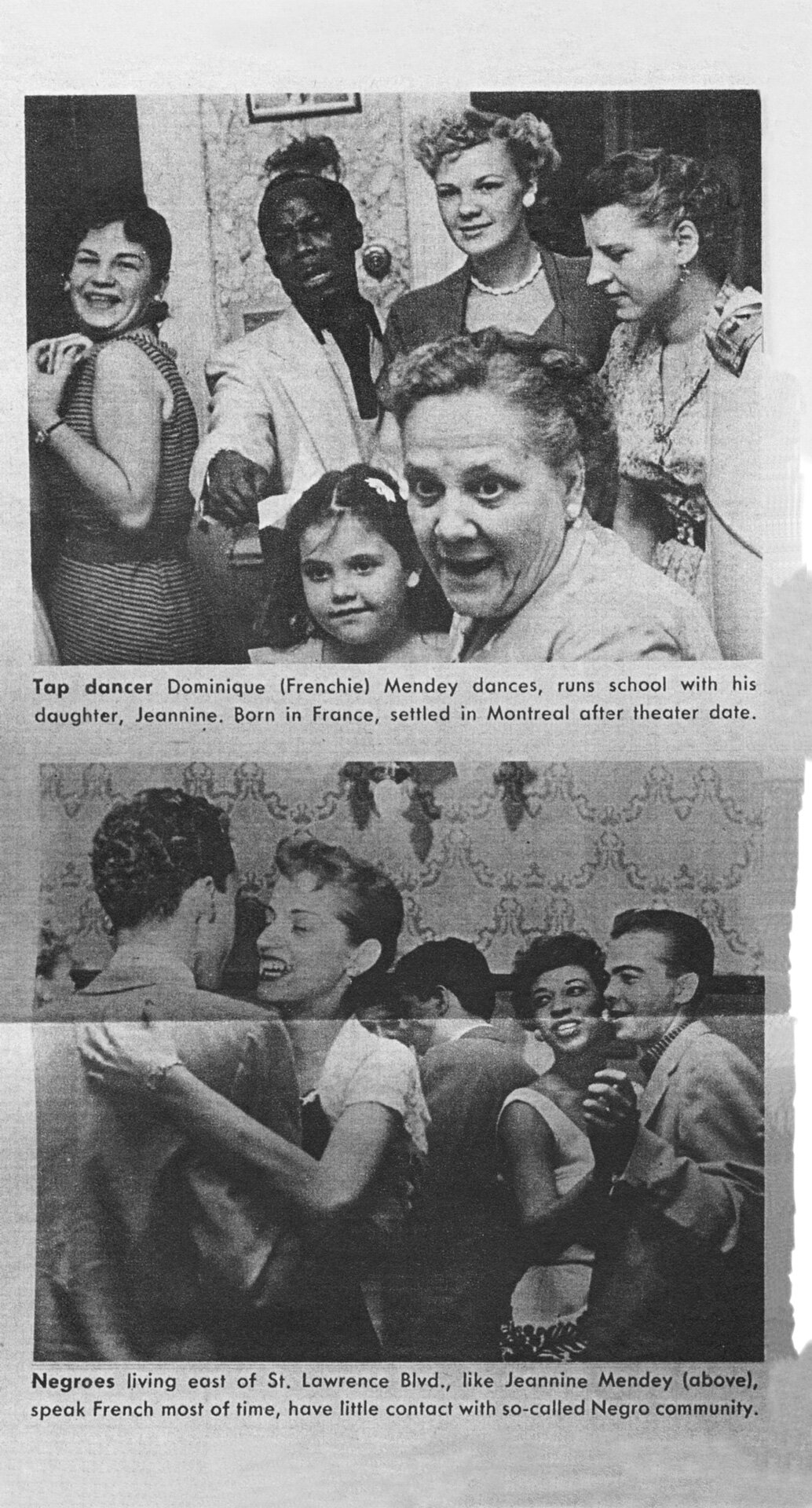
The captions for these images from an unknown source demonstrate both class stratification and the broad range of differences in cultural backgrounds of Montreal’s Black population. Dance is used to demonstrate both. More importantly, the captions reveal that there was a need to state that Black people differed from one another, lived in different parts of the city, came from different parts of the world and that they did not all know one another.
Reproduction from the personal collection of Seika Boye.

Negro Community Centre materials: press release.
Reproductions provided courtesy of Concordia Archives with permission of Negro Community Centre, Shirley Giles.
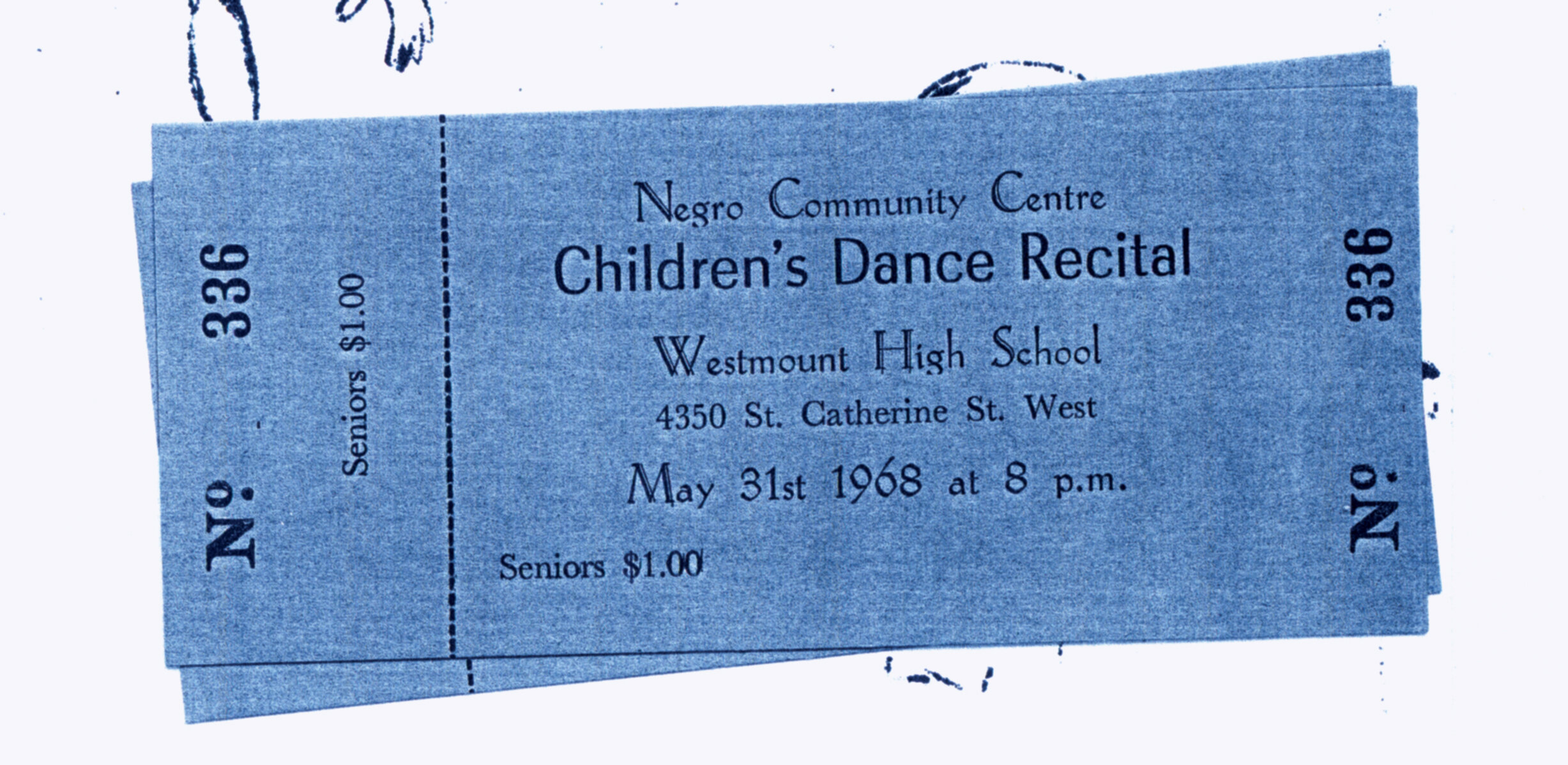
Negro Community Centre materials: ticket.
Reproductions provided courtesy of Concordia Archives with permission of Negro Community Centre, Shirley Giles.
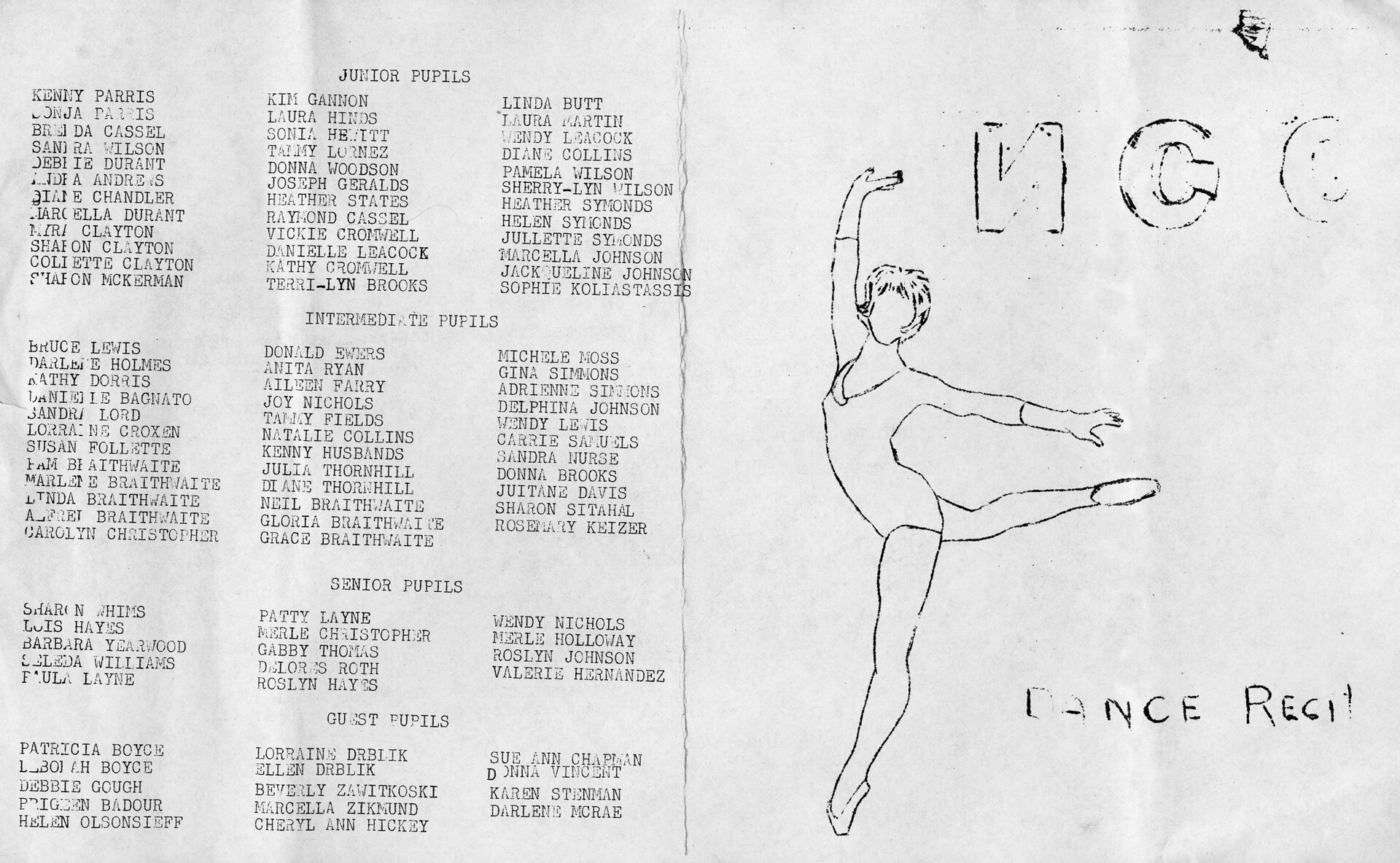
Negro Community Centre materials: Children’s Dance Recital house program.
Reproductions provided courtesy of Concordia Archives with permission of Negro Community Centre, Shirley Giles.
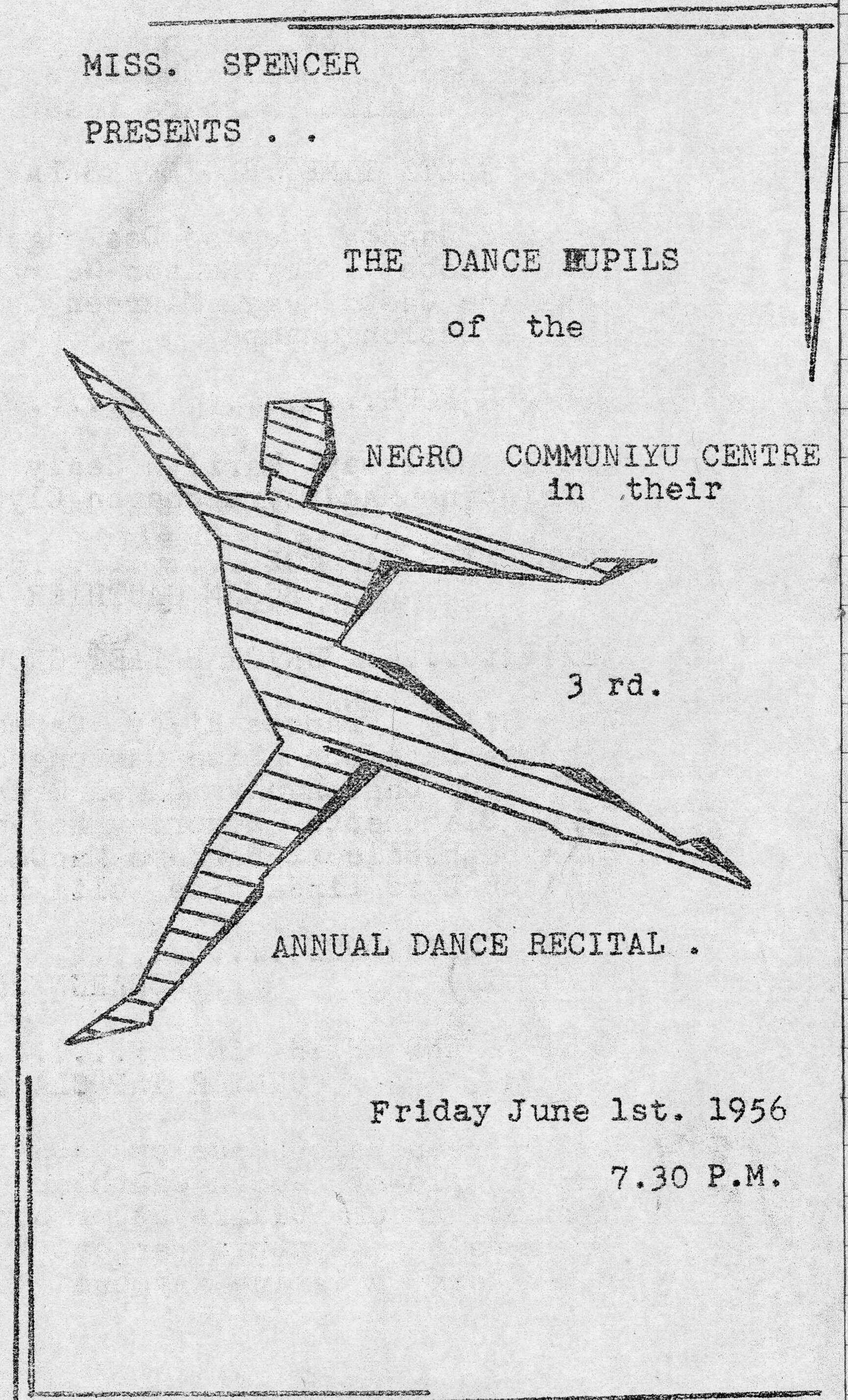
Negro Community Centre materials: Children’s Dance Recital house program.
Reproductions provided courtesy of Concordia Archives with permission of Negro Community Centre, Shirley Giles.

Stairs for Stars house program, Sheldon-Williams Auditorium, February 5-6, 1965.
On loan from the personal collection of Ola Skanks.

Donna and Marianne Skanks in Stairs for Stars revue, 1965.
On loan from the personal collection of Ola Skanks.
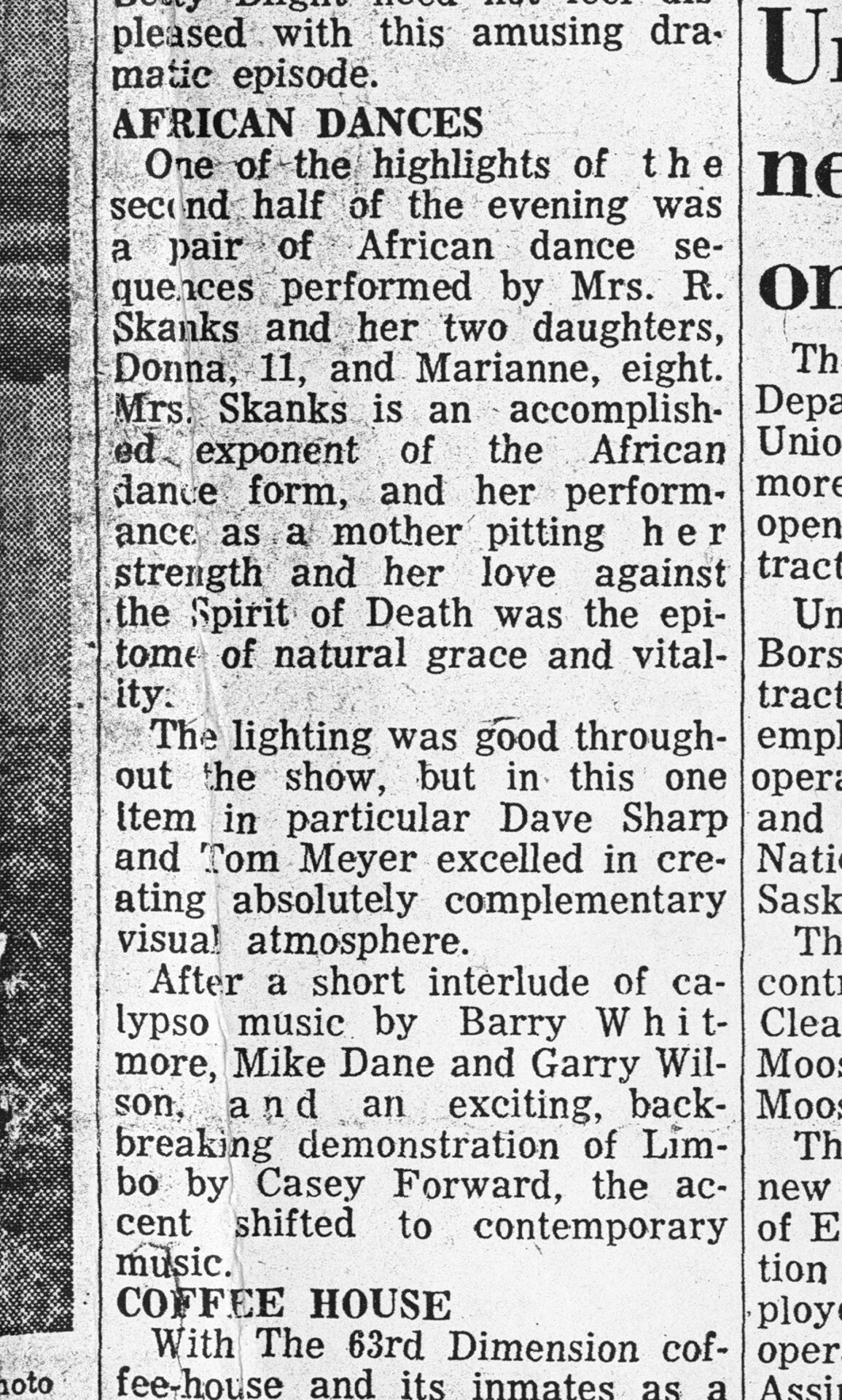
Reproduction of excerpt from “Student talent shines in ‘Gay 90s’ show” by Johnnie Wells, Regina Leader-Post, February 8, 1963.
On loan from the personal collection of Ola Skanks.
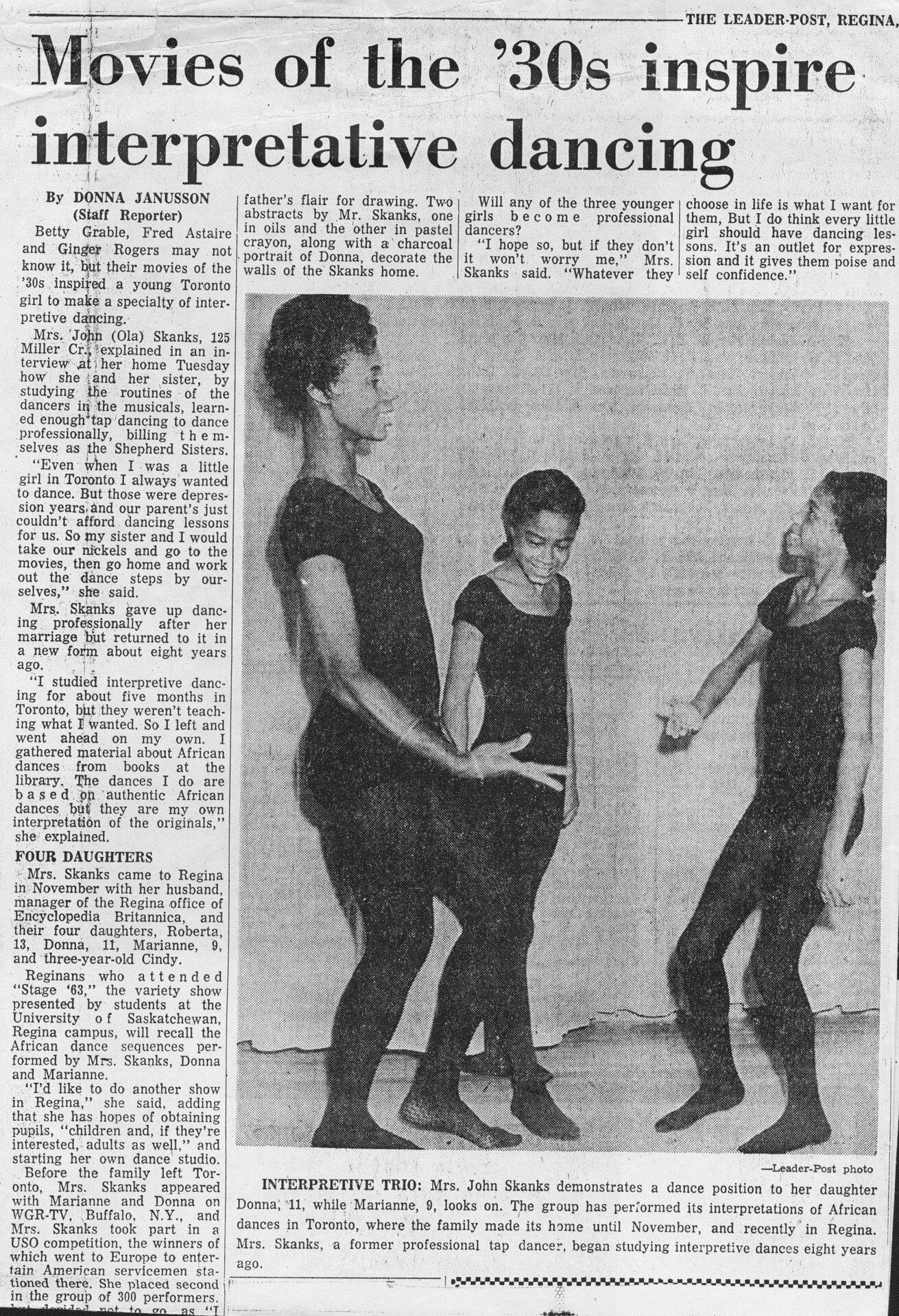
Reproduction of headline and photo for article by Donna Janusson published in the Regina Leader-Post, c. 1963.
On loan from the personal collection of Ola Skanks.
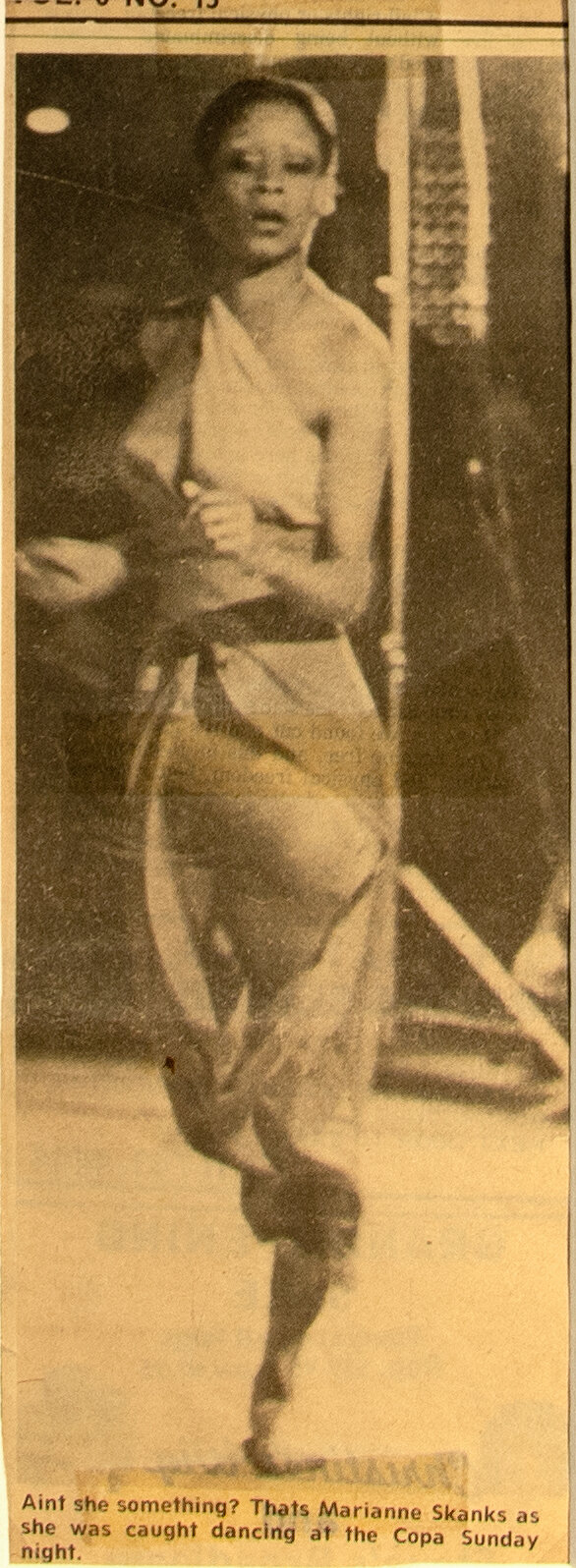
Marianne Skanks performing years later in Toronto, unknown clipping.
On loan from the personal collection of Ola Skanks.
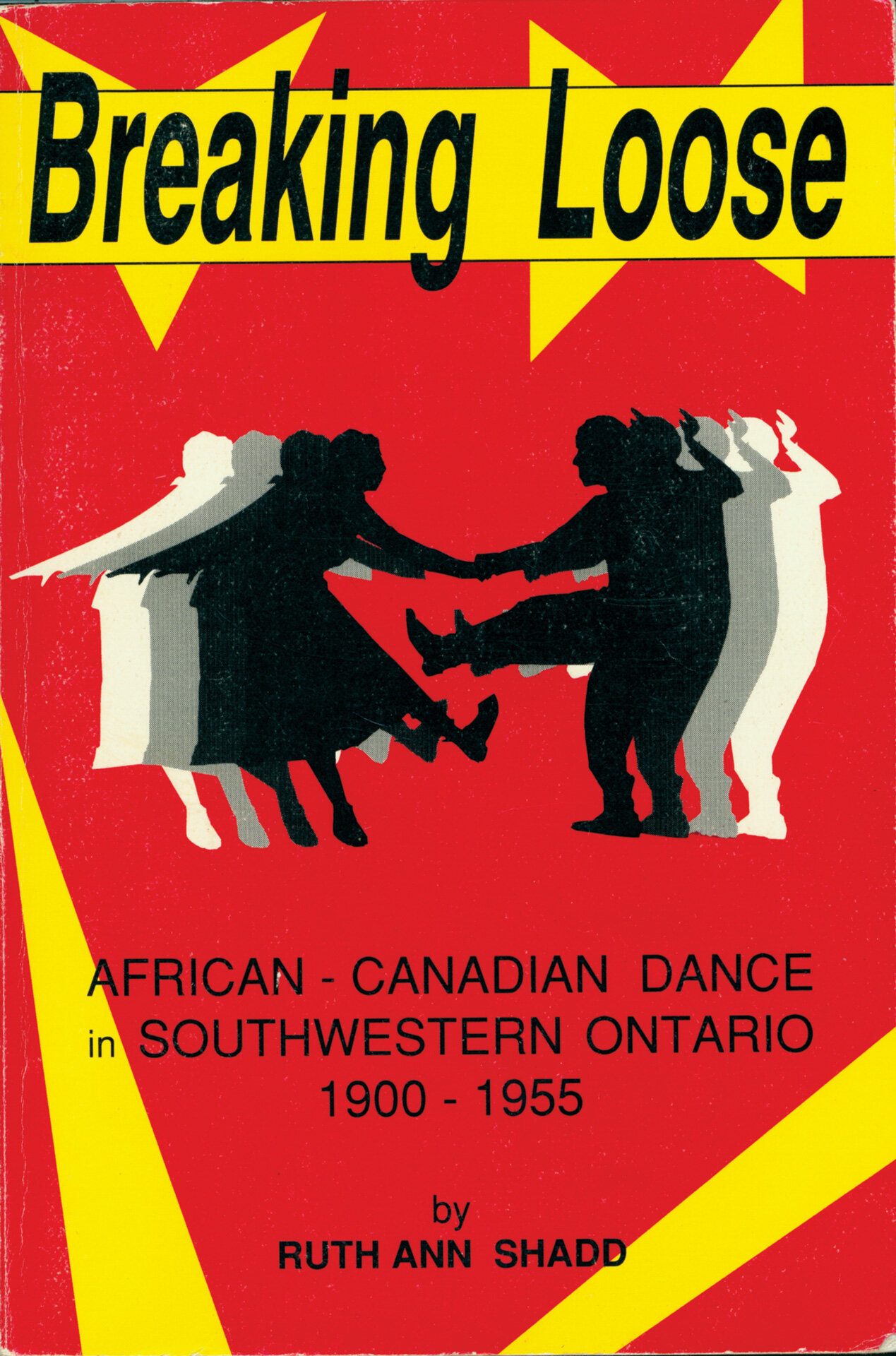
Breaking Loose: African-Canadian Dance in Southwestern Ontario 1900-1955 by Ruth Ann Shadd (self-published by author, 1995)
Reproductions from the personal collection of Seika Boye
This book is an example of local history documented through dance. The Windsor, North Buxton, Kent, Chatham and Dresden Townships were an area of significant Black settlement in the mid-nineteenth century in the years preceding emancipation in the United States. This area was a destination for the Underground Railroad. The close proximity to Detroit alongside the rural location and geographic segregation of Black families in this region resulted in a range of dancing styles from square dancing to popular African-American forms such as the jive and jitterbug during the first half of the twentieth century.
The documentary film, The Greatest Freedom Show on Earth (Orphan Boy Films/Keshet Productions/TVO 2015) and Emancipation Day by Natasha Henry (Dundurn Press, 2010) are further examples of sources that document important social and celebratory gatherings for Black communities in Canada including the annual celebration of the passing of the Abolition of the Slavery Act on August 1, 1834, which is known as Emancipation Day.
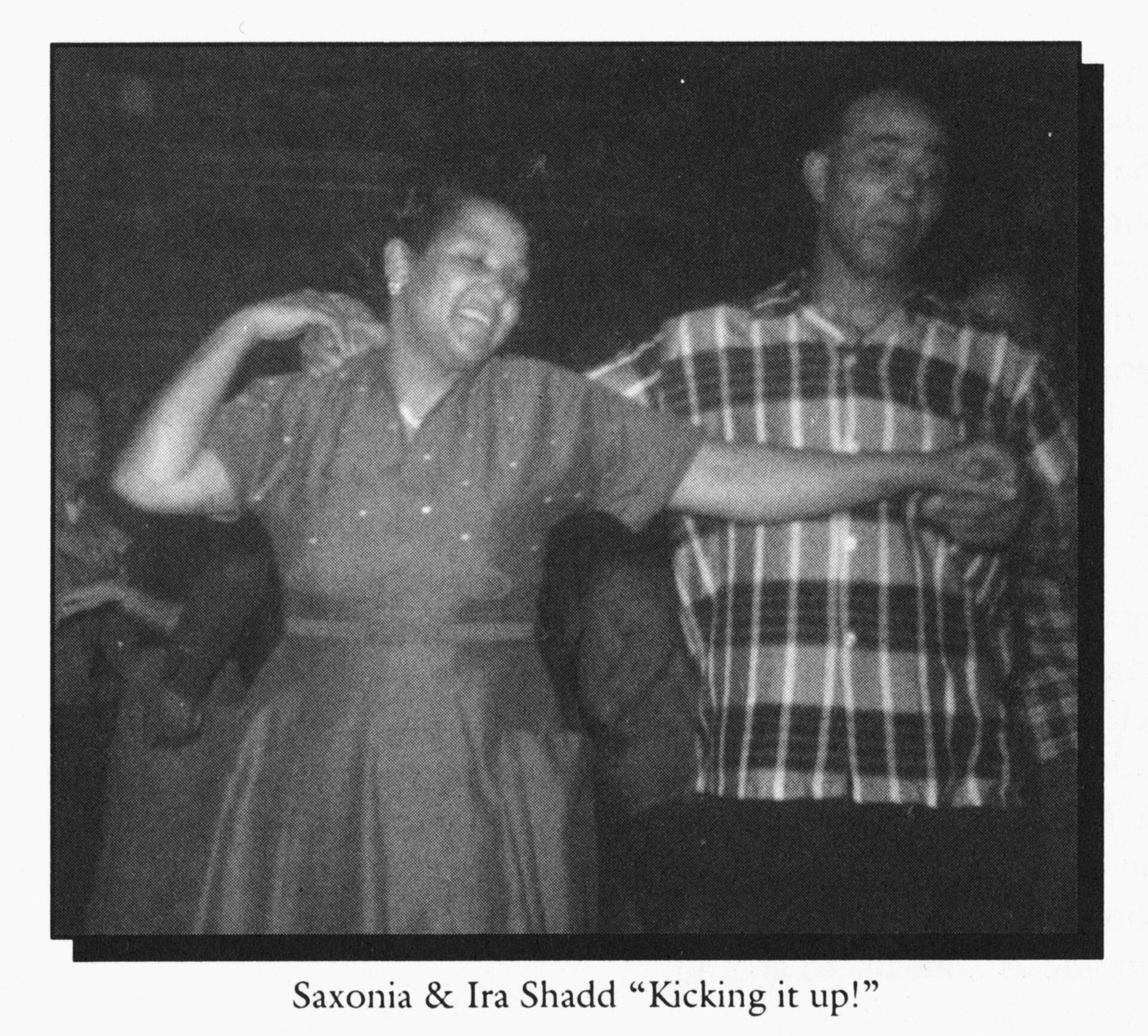
Image taken from the book “Breaking Loose: African-Canadian Dance in Southwestern Ontario 1900-1955” by Ruth Ann Shadd (self-published by author, 1995).
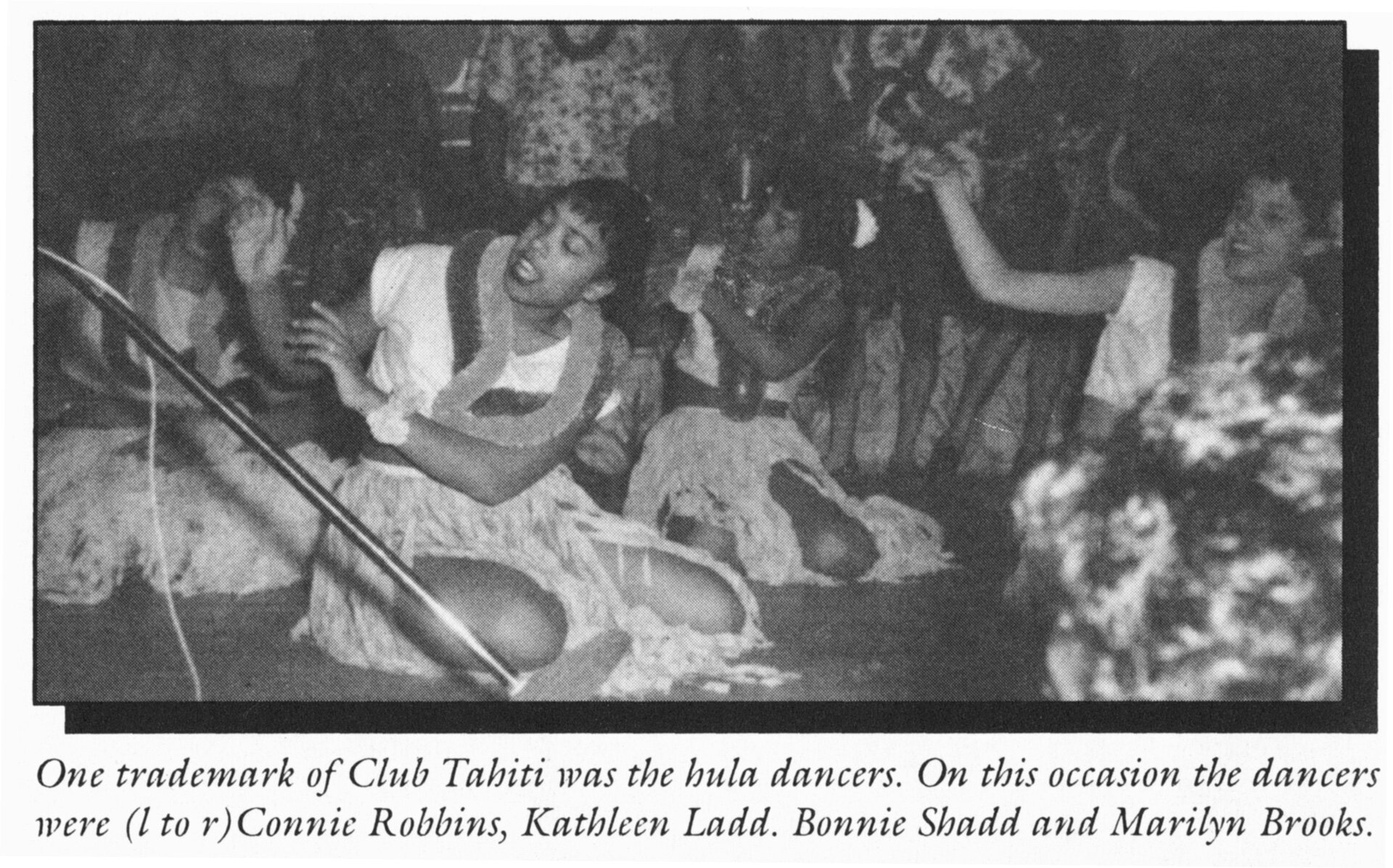
Image taken from the book “Breaking Loose: African-Canadian Dance in Southwestern Ontario 1900-1955” by Ruth Ann Shadd (self-published by author, 1995).
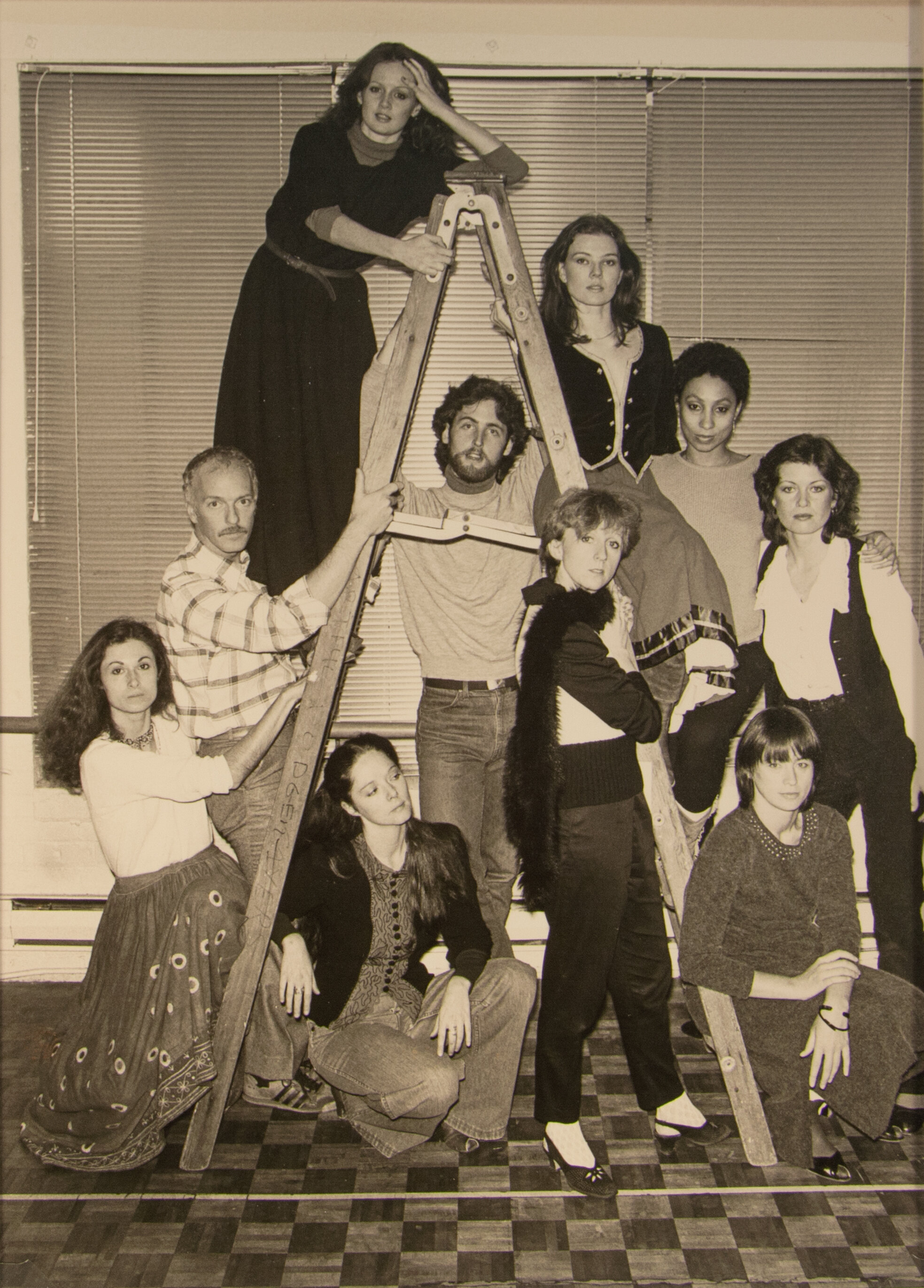
Artists associated with the Pavlychenko Studio, (L-R) Claudia Moore, David Wood, Nancy Ferguson, Anna Blewchamp, Murray Darroch, Susan Cash, Holly Small, Kathryn Brown, Susan McNaughton and Gabby Micelli (Kamino).
Dance in Canada Photo Collection, Dance Collection Danse.
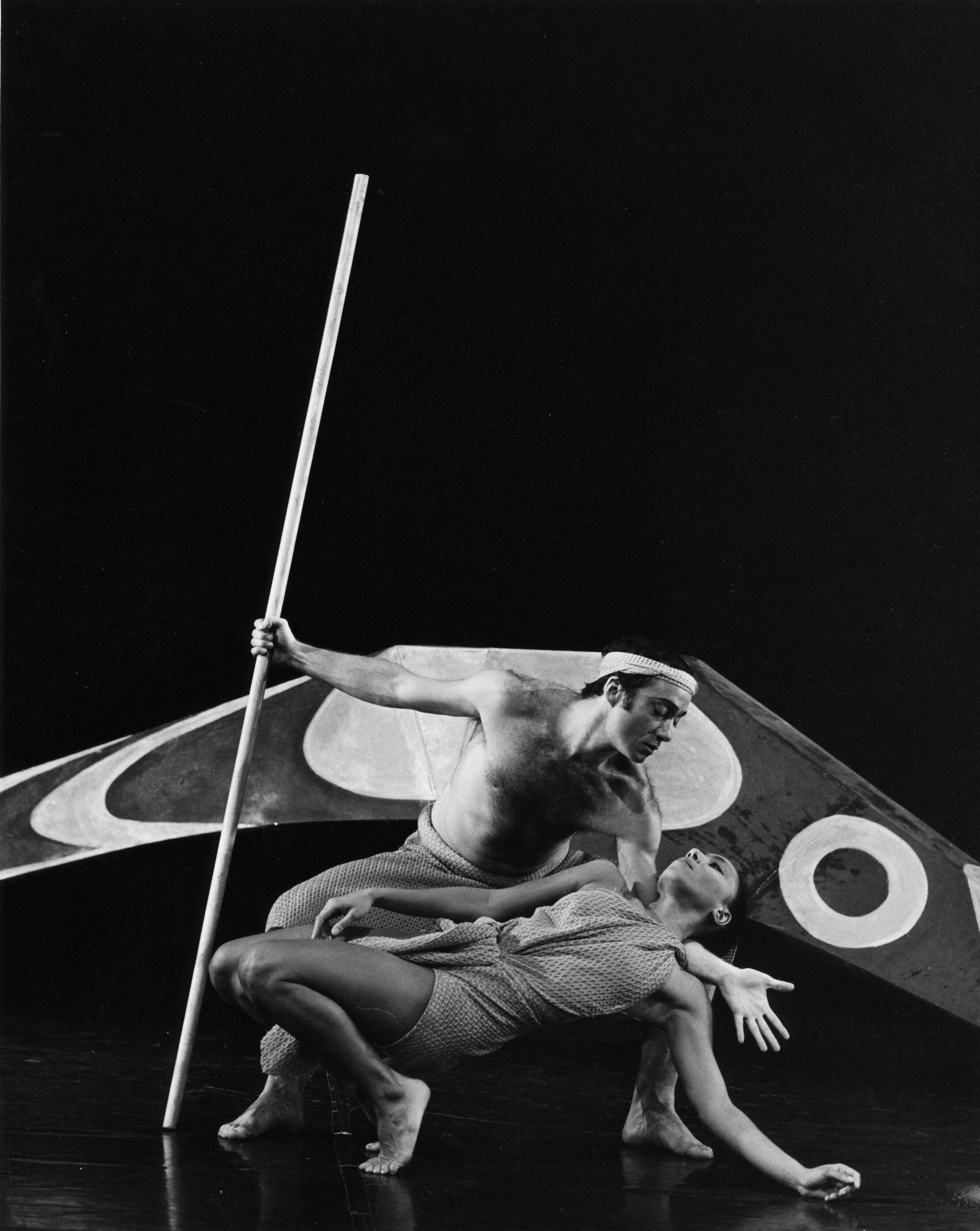
David Earle and Kathryn Brown in Earle’s Boat, River, Moon for Toronto Dance Theatre, c. 1972.
Photo: Andrew Oxenham, Andrew Oxenham Photo Collection, Dance Collection Danse
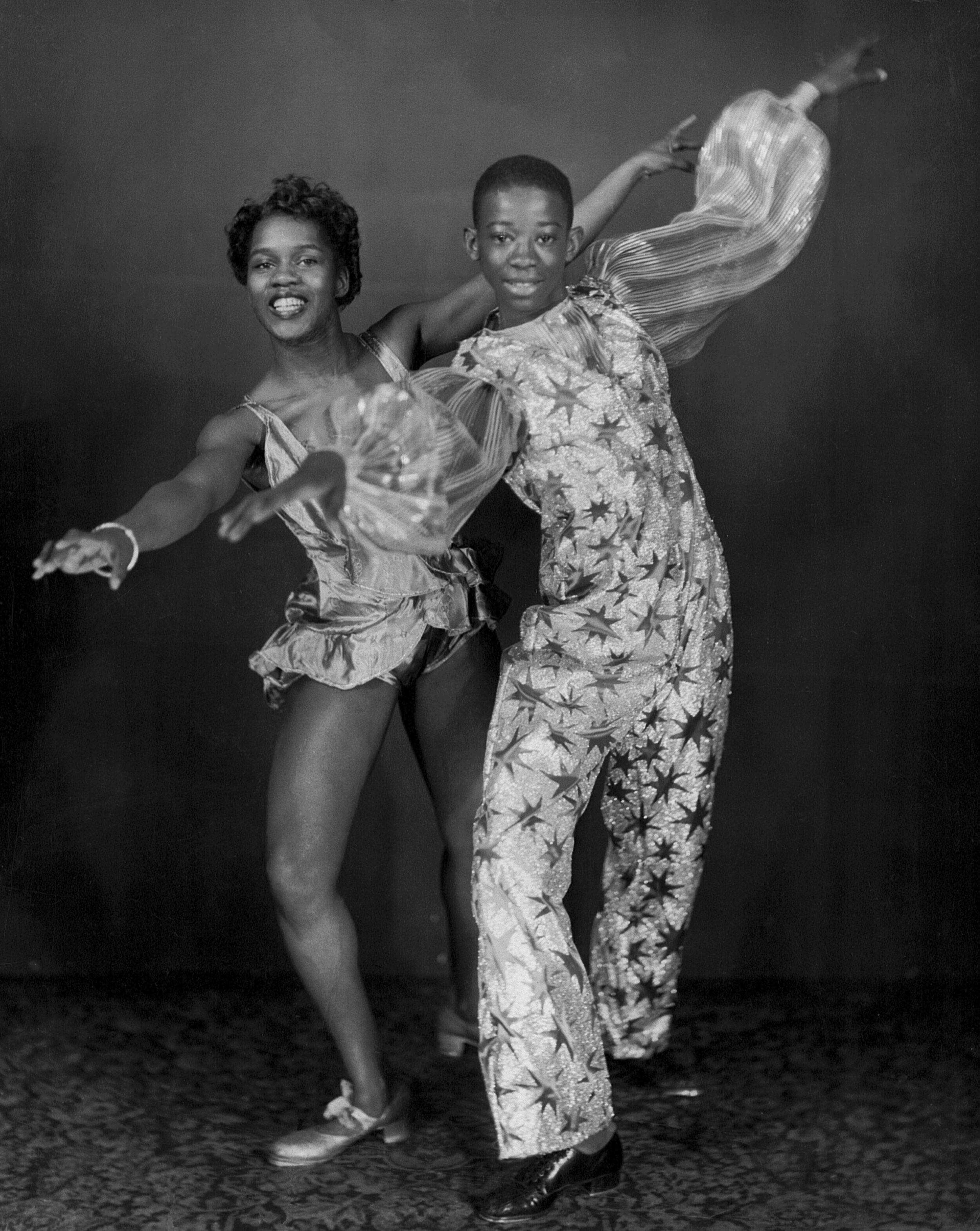
Ethel Bruneau and Cornelius “Poppy” Scott, The Melody Twins, c. 1950.
Reproduced from the Ethel Bruneau Electronic Archives, Dance Collection Danse.
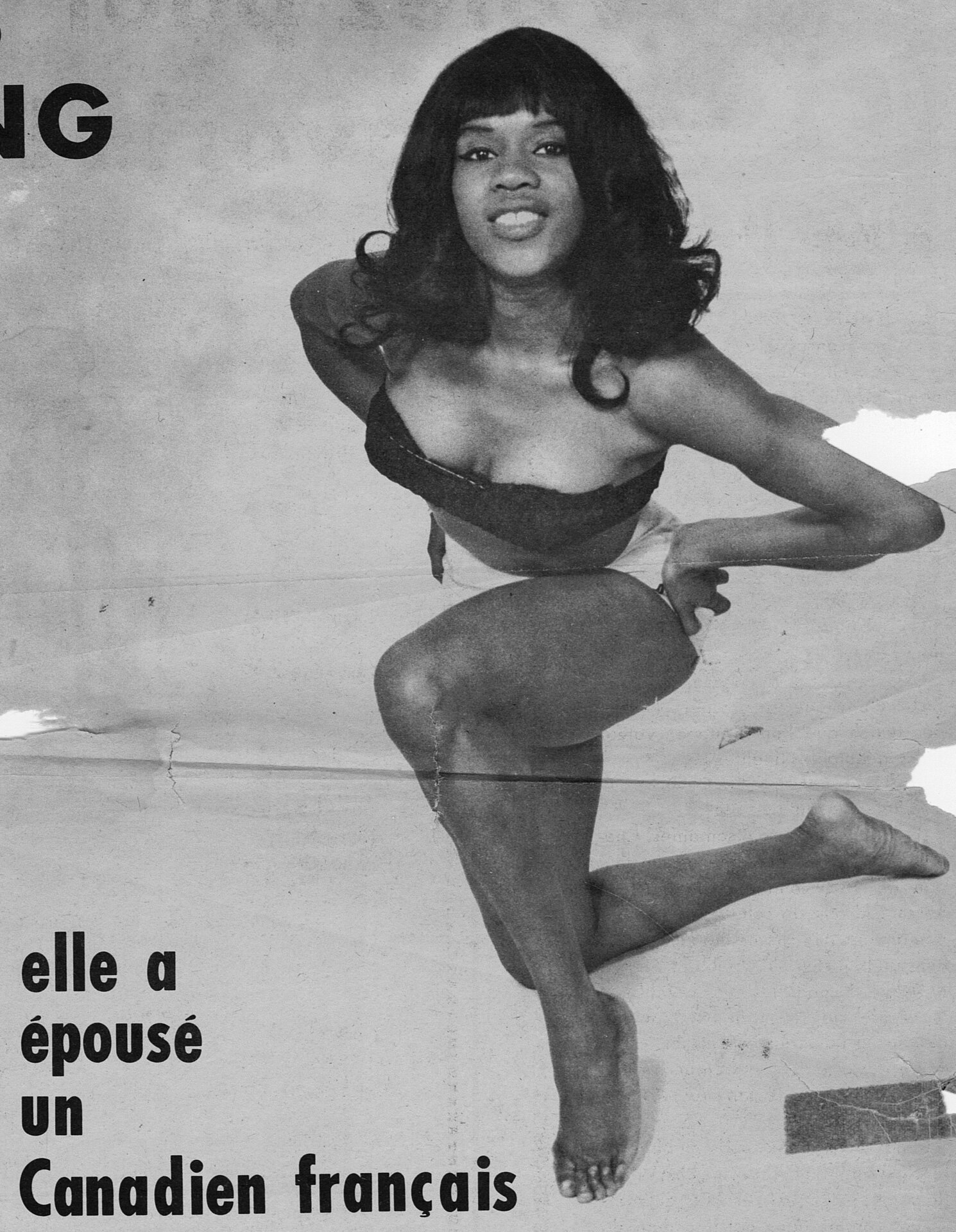
Ethel Bruneau items.
Clipping from Le Cabaret, March 19, 1966.
Reproduced from the Ethel Bruneau Electronic Archives, Dance Collection Danse.
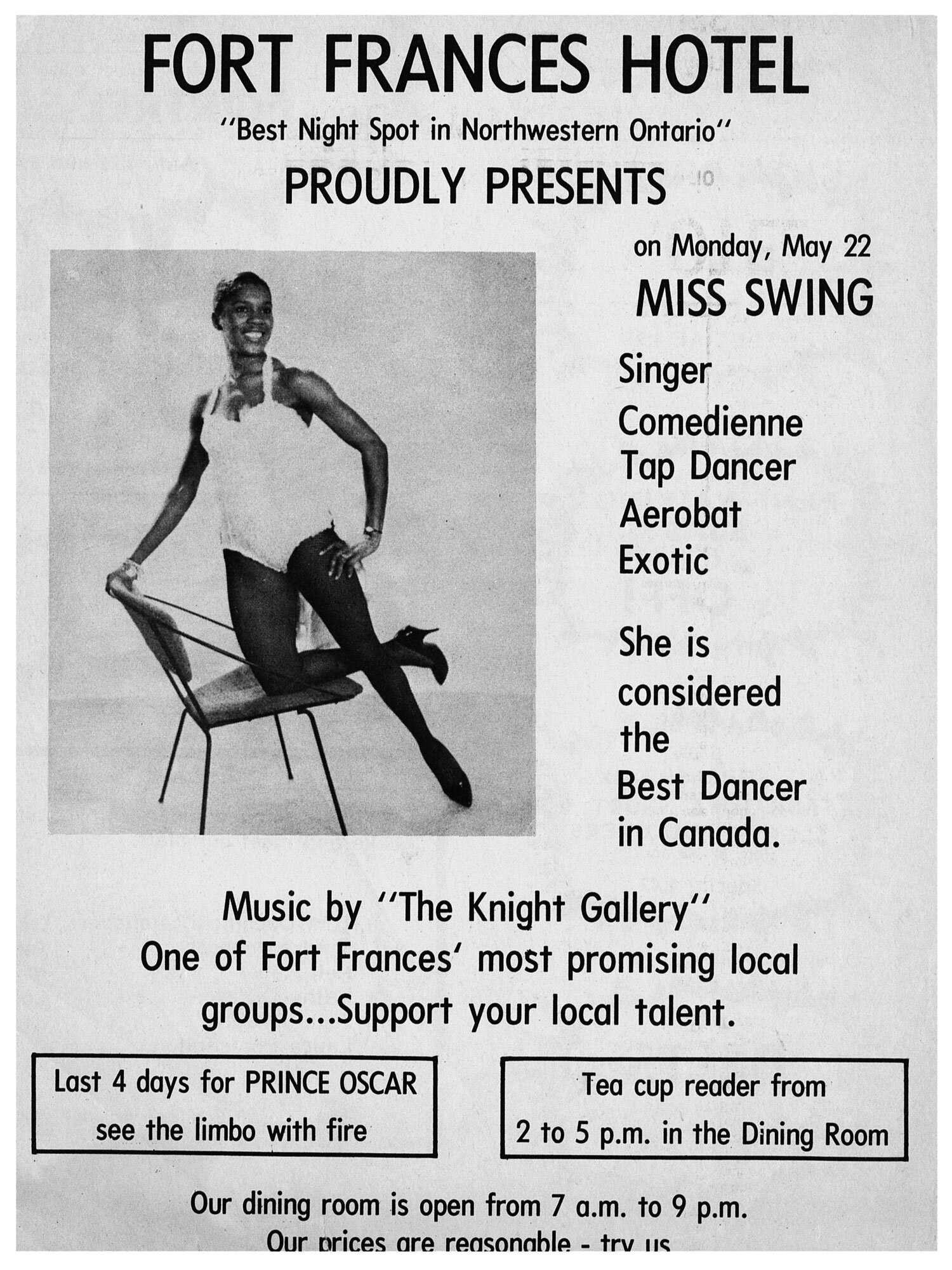
Ethel Bruneau items.
Miss Swing poster, Fort Frances Hotel, c. 1970.
Reproduced from the Ethel Bruneau Electronic Archives, Dance Collection Danse.
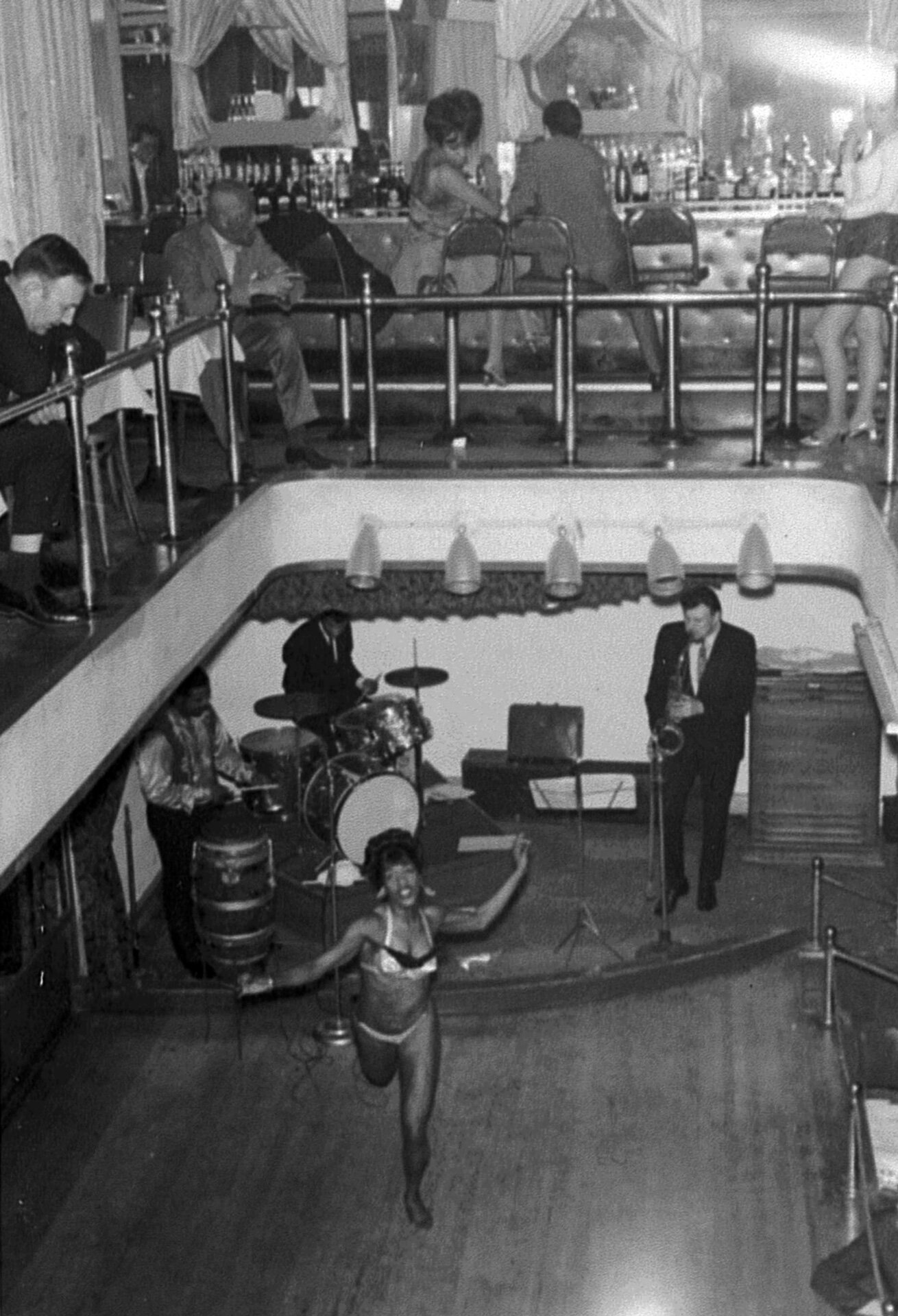
Ethel Bruneau at Rockhead’s Paradise, Montreal, c. 1970.
Reproduced from the Ethel Bruneau Electronic Archives, Dance Collection Danse.
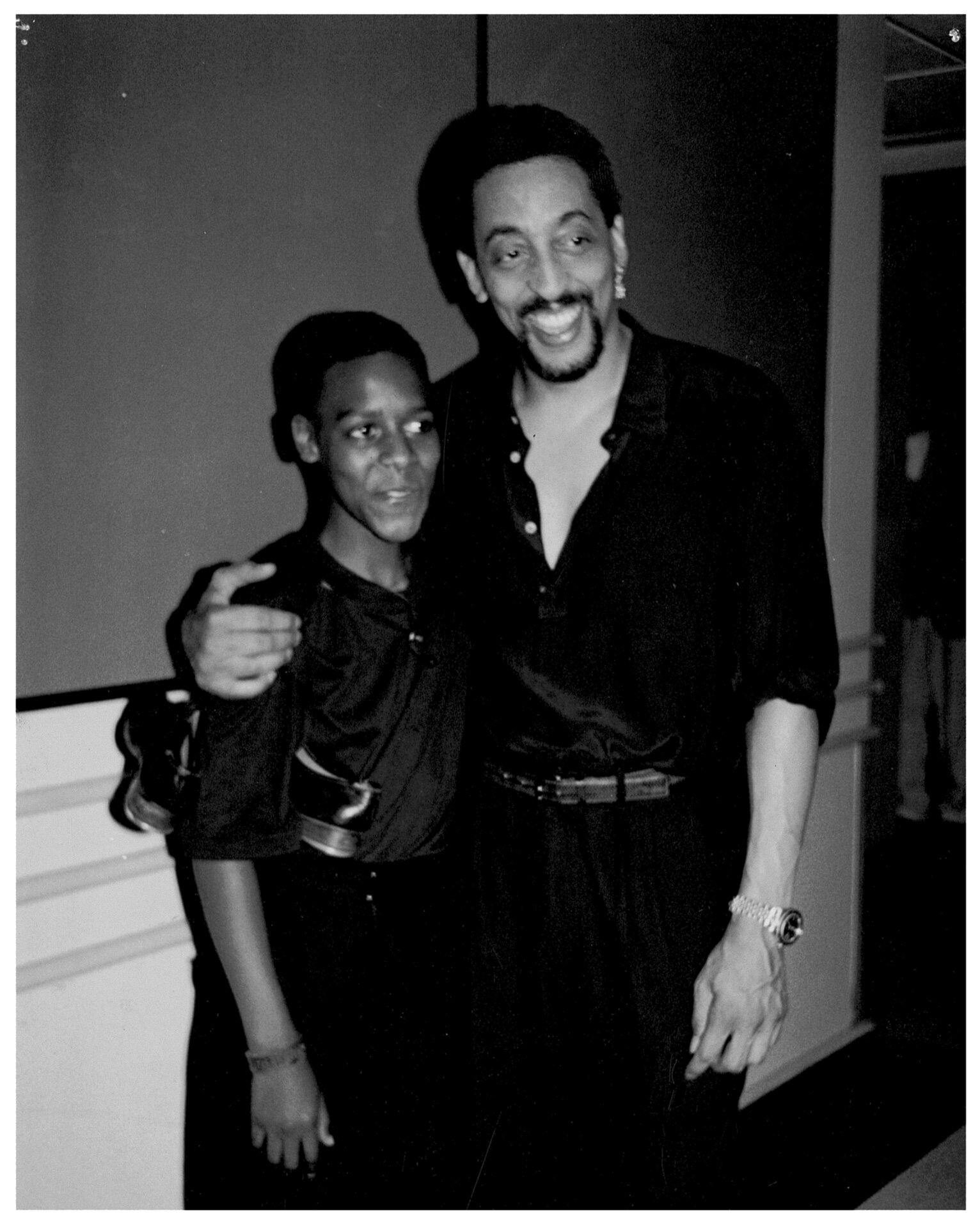
Ethel Bruneau’s student Travis Knights with her life-long friend Gregory Hines, 1996.
Reproduced from the Ethel Bruneau Electronic Archives, Dance Collection Danse.
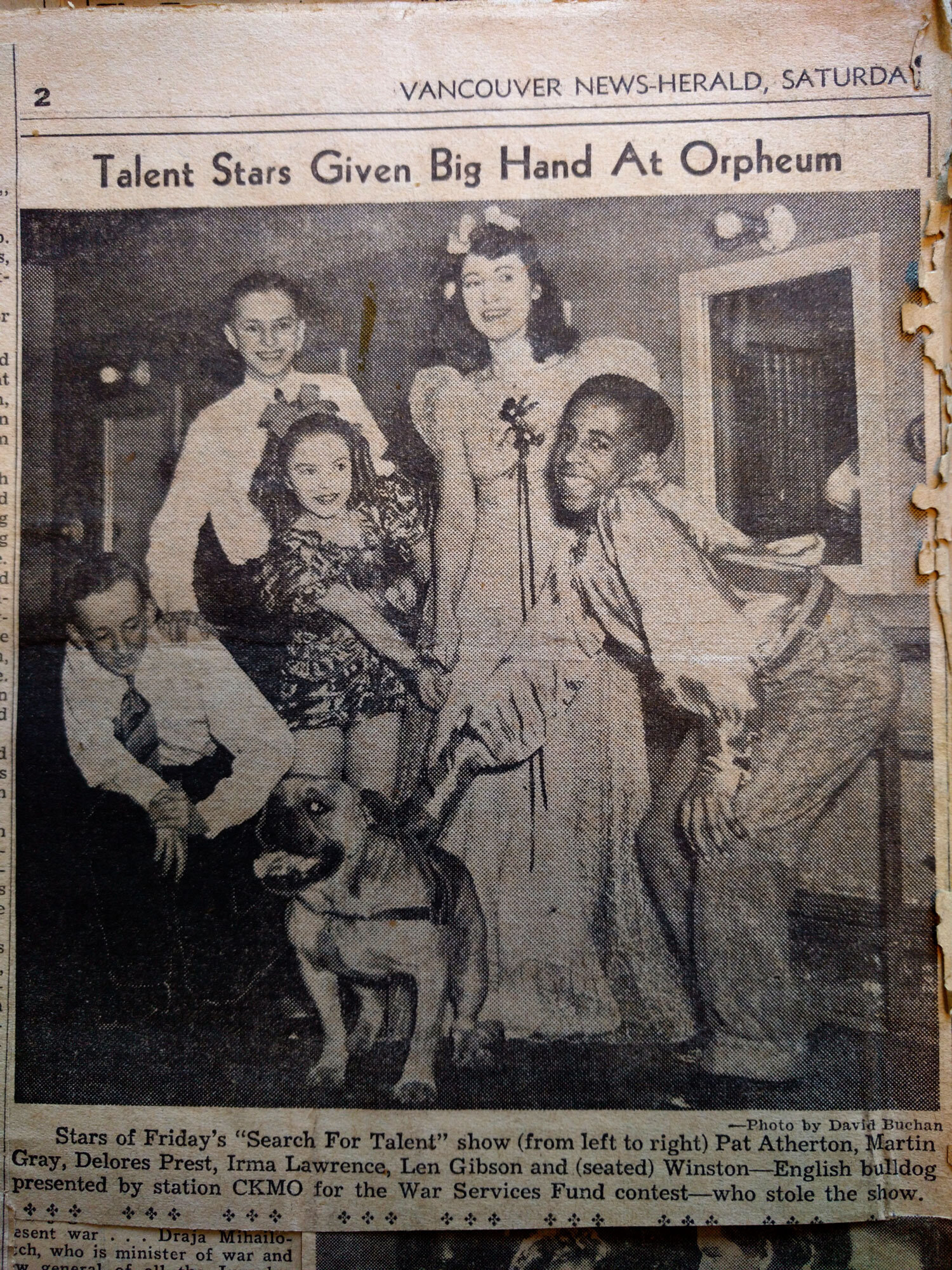
Clipping reproduction — Youthful Entertainers Feature Sixth “Search for Talent Show”
Clipping reproduction -- Youthful Entertainers Feature Sixth “Search for Talent Show”
Vancouver News-Herald clippings featuring Len Gibson in the “Search for Talent” show, Vancouver, 1941 Reproductions from the personal research collection of Seika Boye.
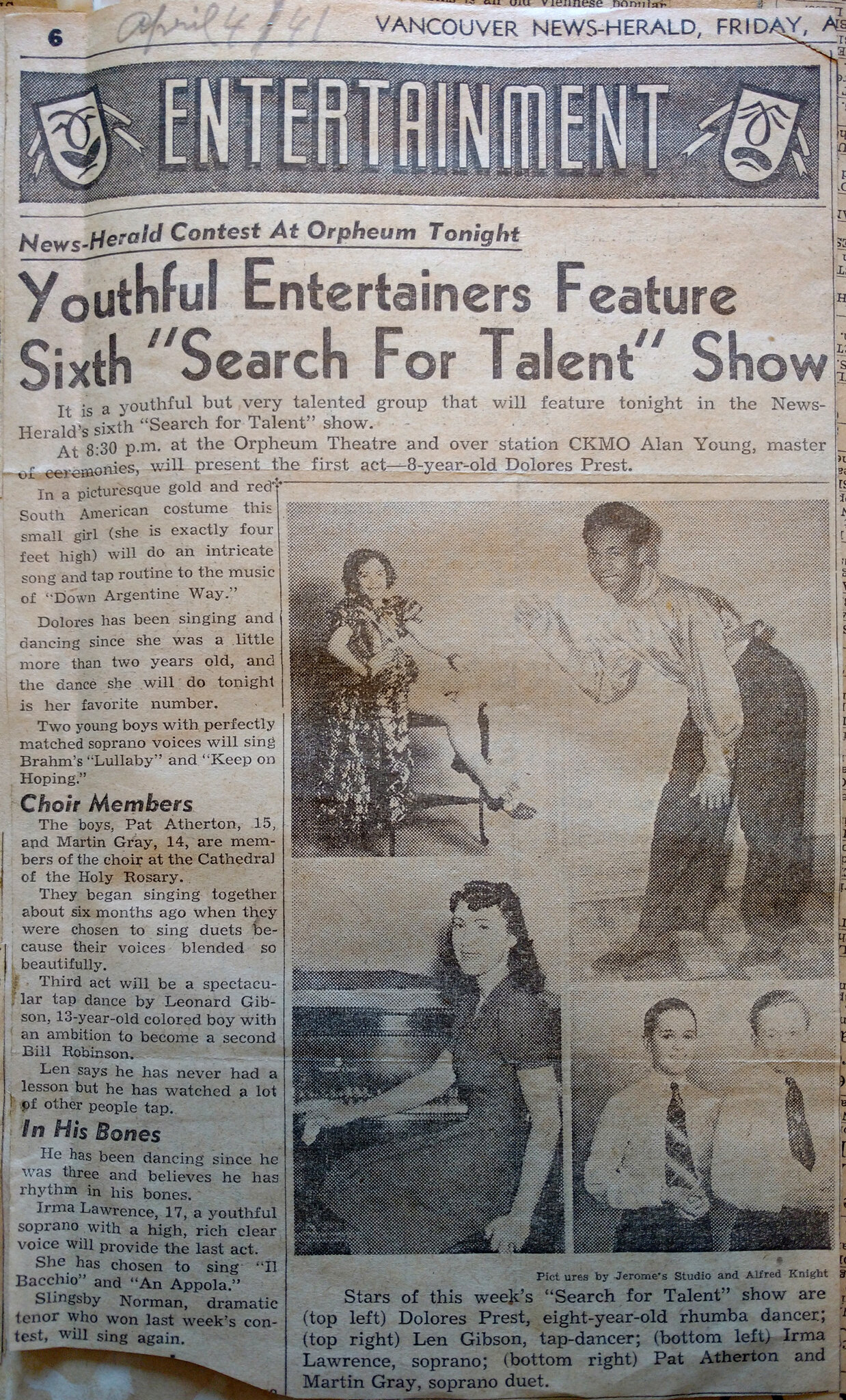
Len Gibson clipping reproduction — Talent Stars Given Big Hand at Orpheum
Len Gibson clipping reproduction — Talent Stars Given Big Hand at Orpheum
Vancouver News-Herald clippings featuring Len Gibson in the “Search for Talent” show, Vancouver, 1941. Reproductions from the personal research collection of Seika Boye.
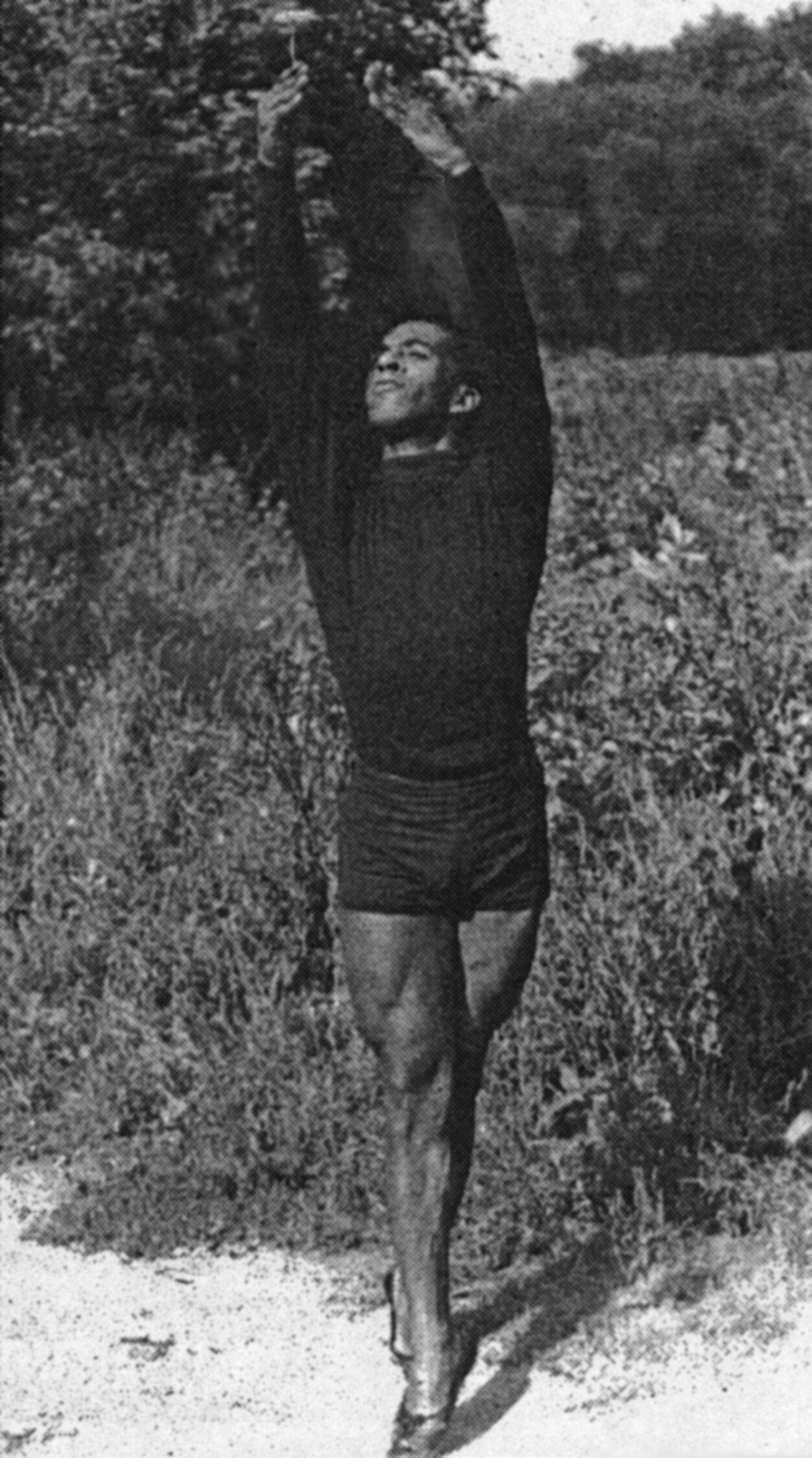
Len Gibson, c. 1950.
Leonard Gibson Electronic Archives, Dance Collection Danse.
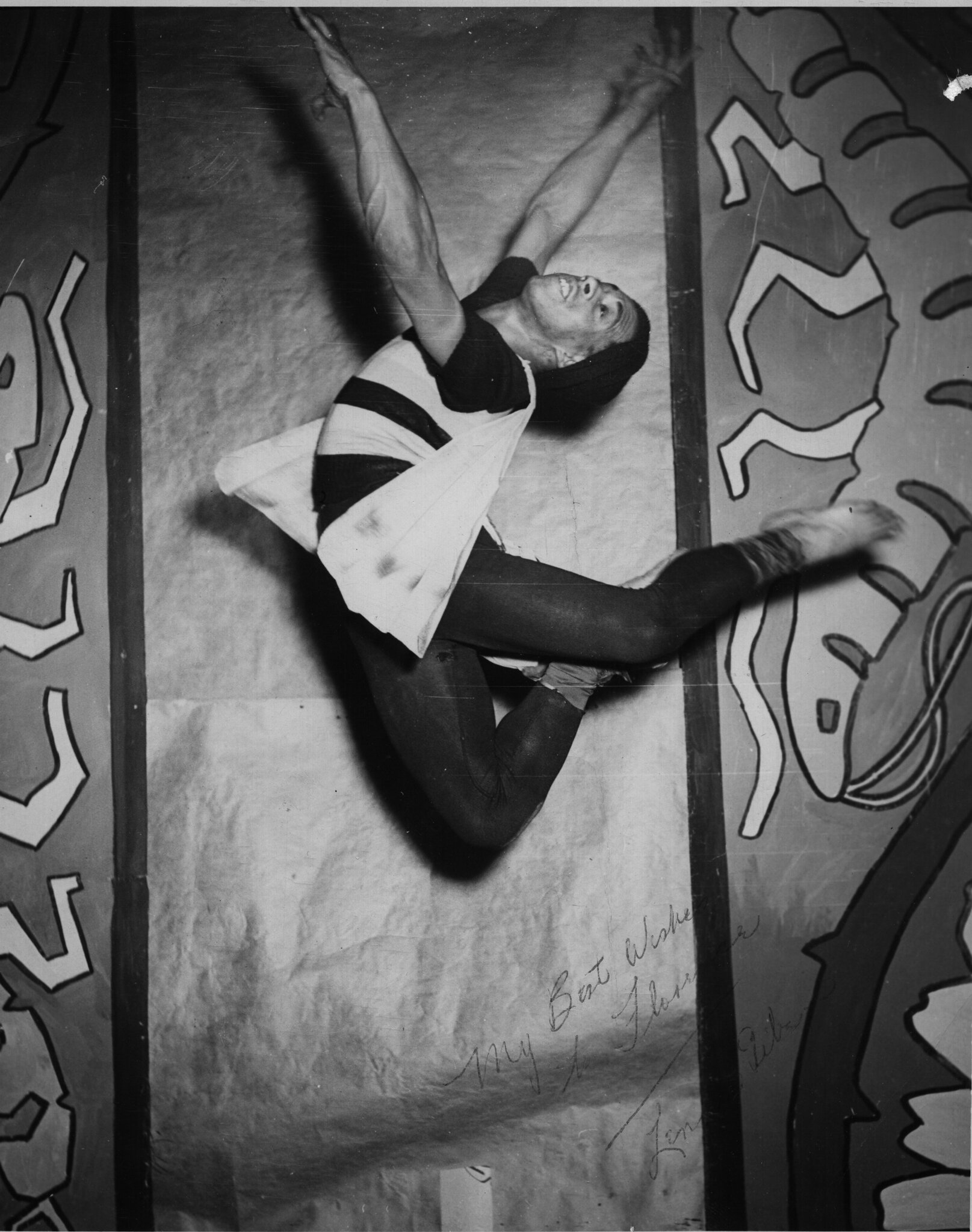
Len Gibson in a photo given to Victoria, BC, dance teacher Florence Clough, c. 1950.
Florence Clough Electronic Archives, Dance Collection Danse.
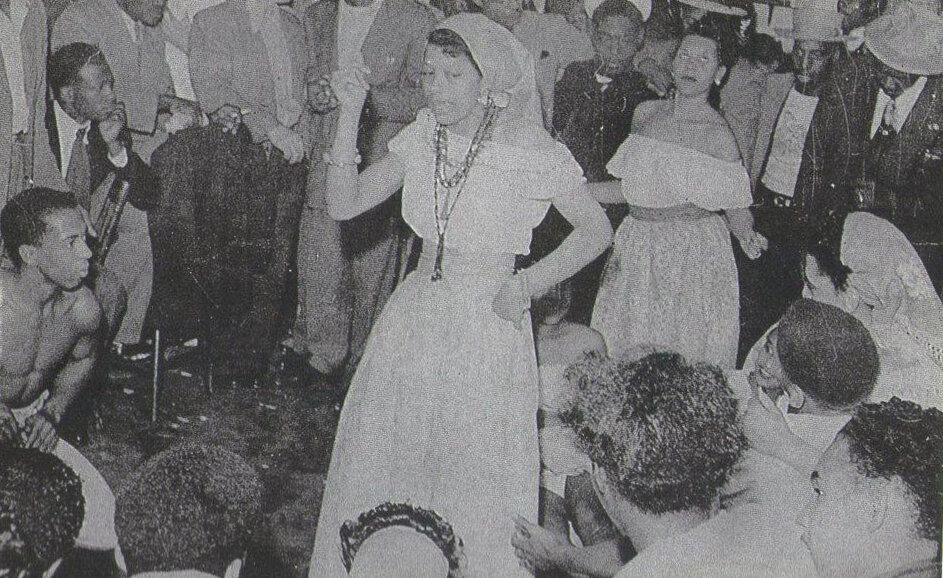
Group scene with Leonard Gibson in the corner on drums, Vancouver, c. 1950s.
Reproduction of image courtesy of the Gibson and King families.

Len Gibson, Eleanor Collins and Austin “Chic” Gibson in an excerpt from an unknown television guide regarding Bamboula, 1954.
Photo courtesy of Len Gibson
Leonard Gibson Electronic Archives, Dance Collection Danse.
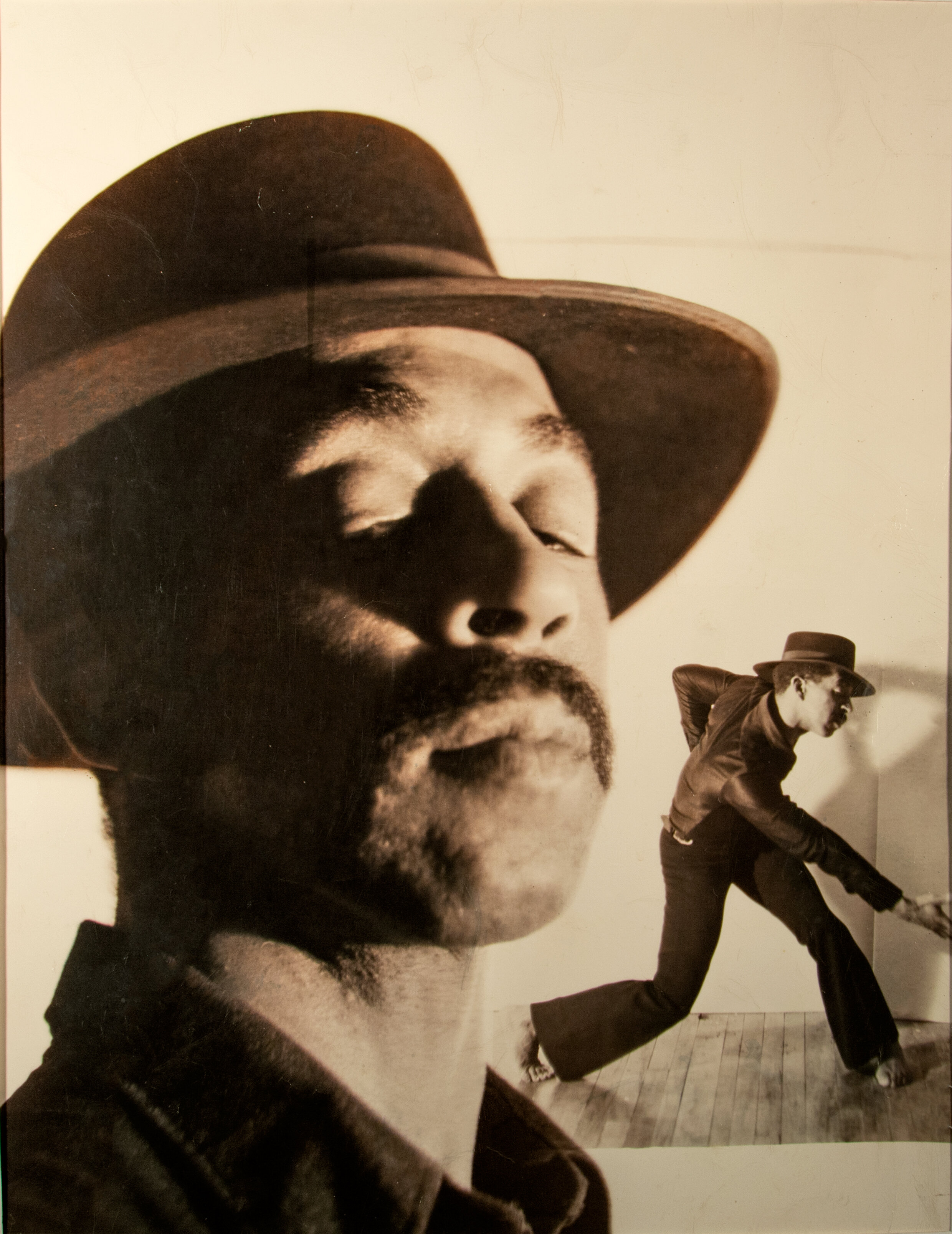
Photo collage of Len Gibson, photographer unknown, c. 1965.
Leonard Gibson Portfolio, Dance Collection Danse.
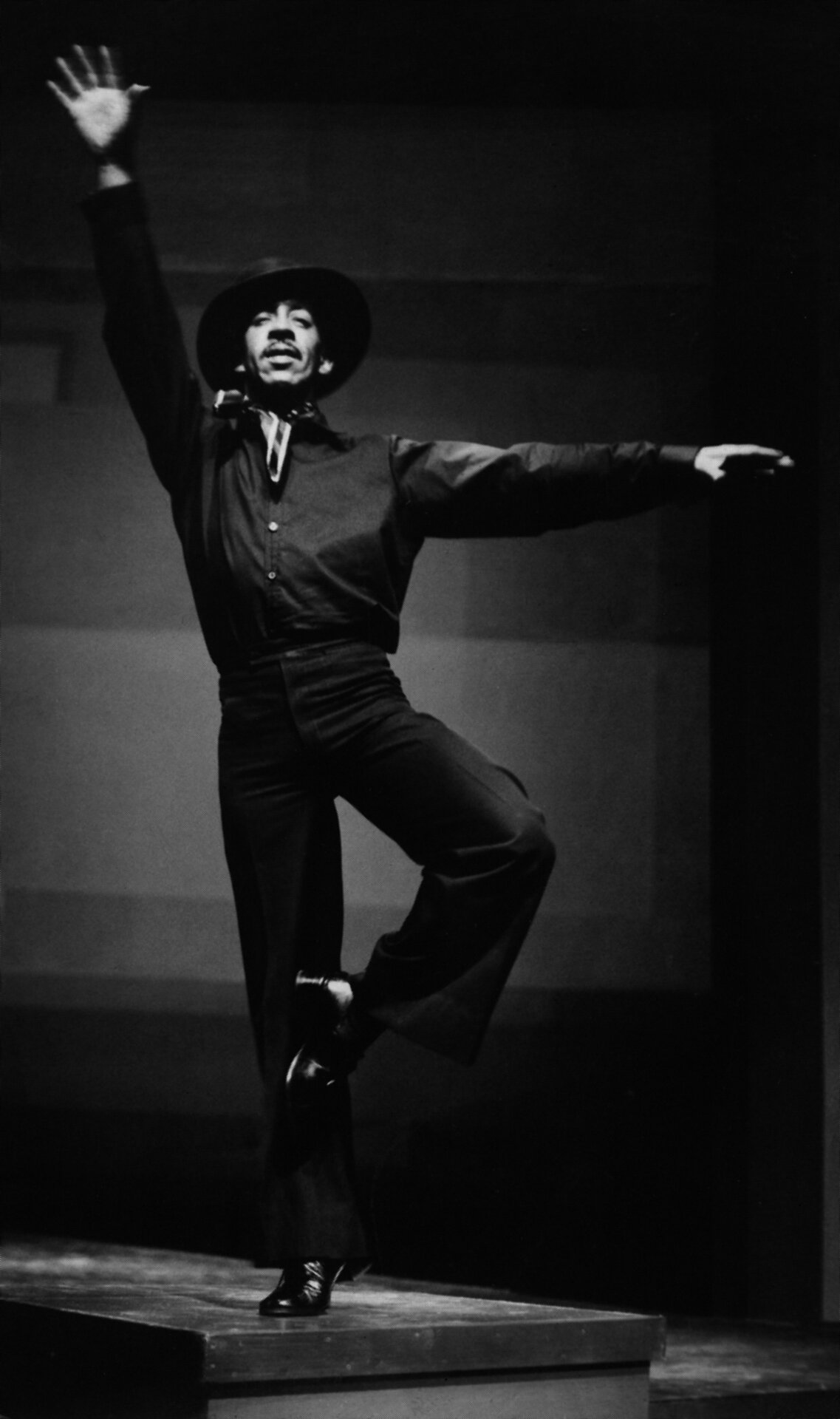
Len Gibson.
Dance Collection Danse Archives.
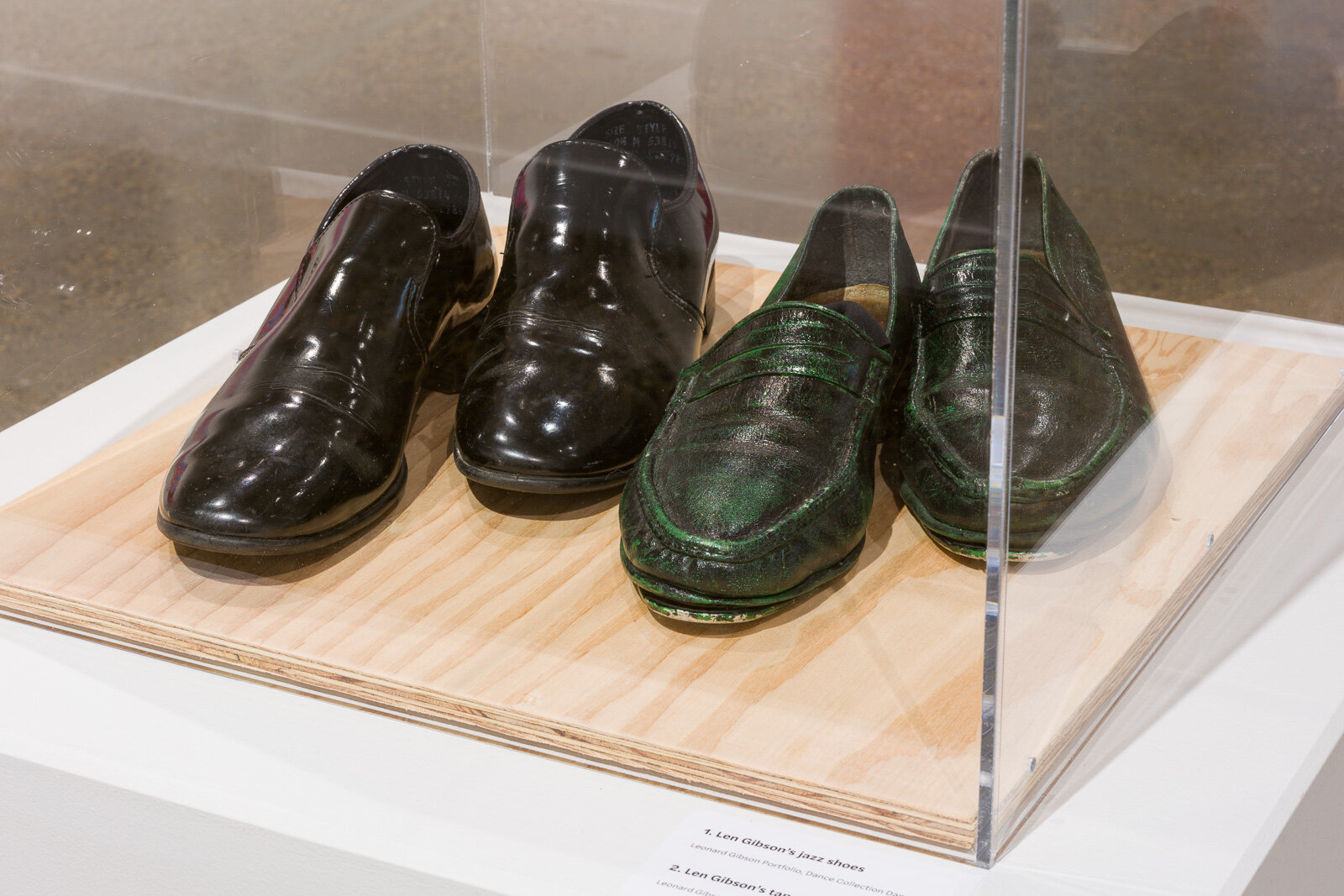
Len Gibson’s jazz shoes
Leonard Gibson Portfolio, Dance Collection Danse
Len Gibson’s tap shoes
Leonard Gibson Portfolio, Dance Collection Danse
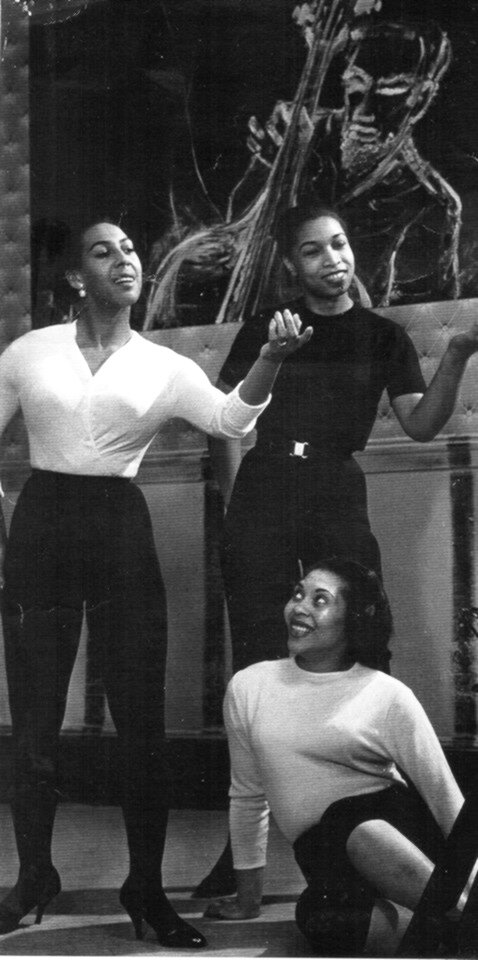
Thelma Gibson, Marcella Choo Choo King and Janet Gibson, Vancouver, c. 1950s.
Reproduction of image courtesy of the Gibson and King families.
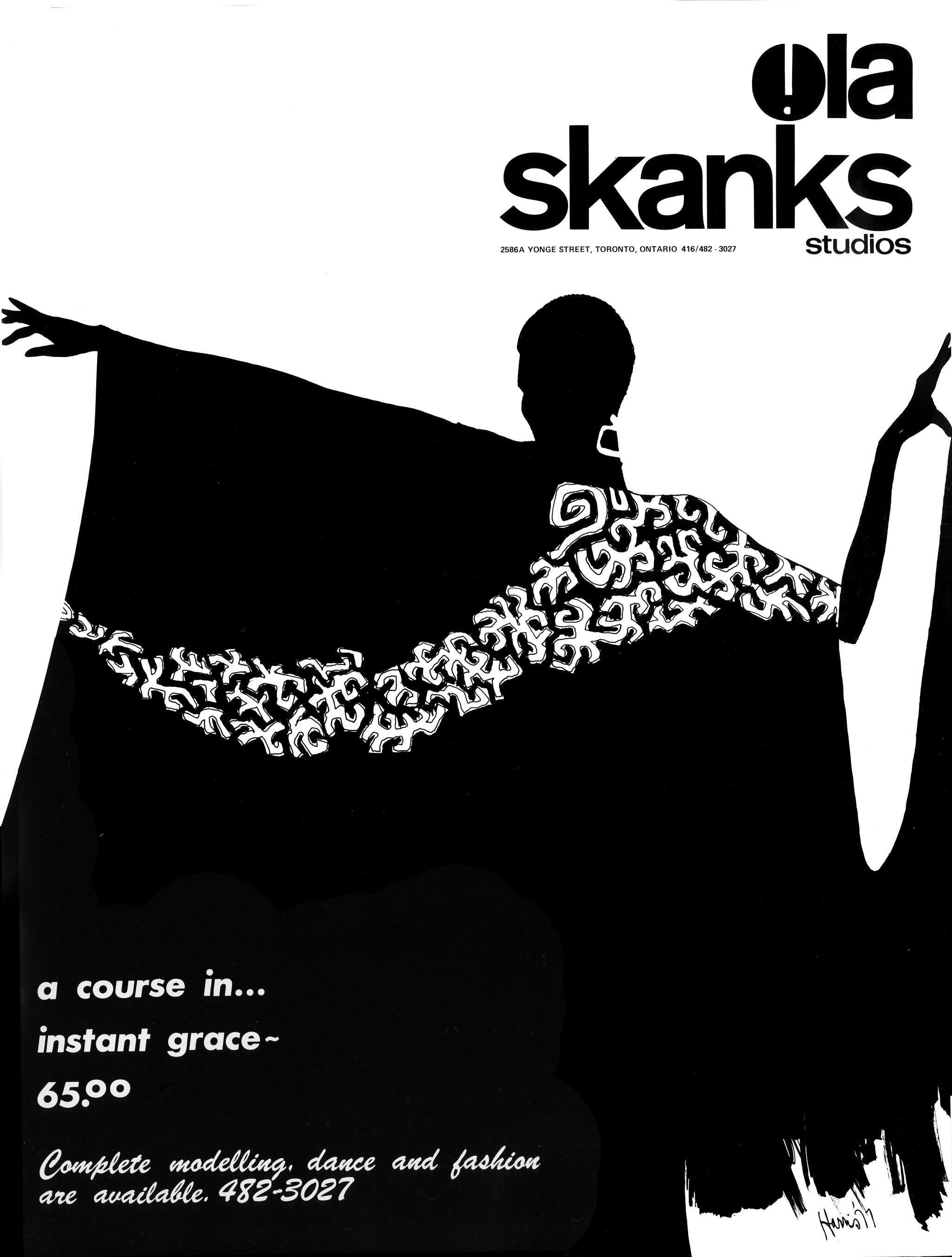
Ola Skanks poster
Ola Skanks poster.
Poster for Ola Skanks Studios, 1977 Dance Collection Danse Poster Collection.
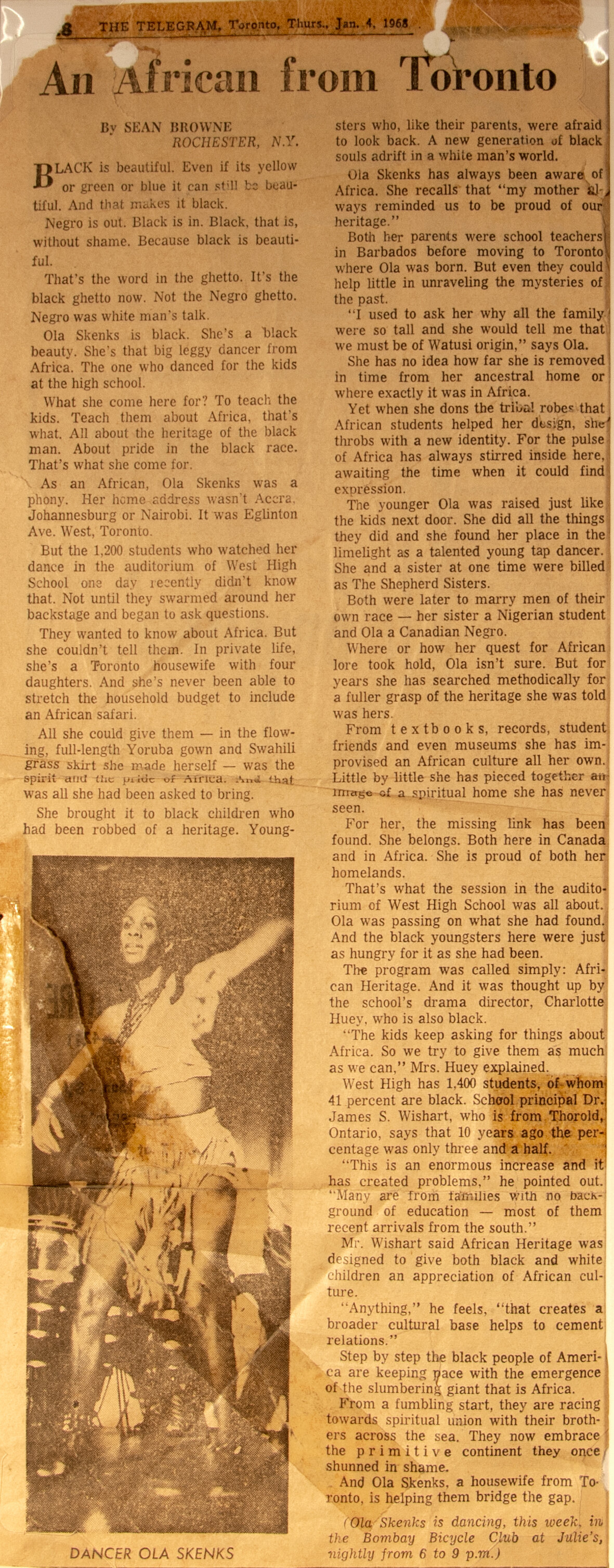
“An African from Toronto” news clipping from the Toronto Telegram, January 4, 1968.
On loan from the personal collection of Ola Skanks.
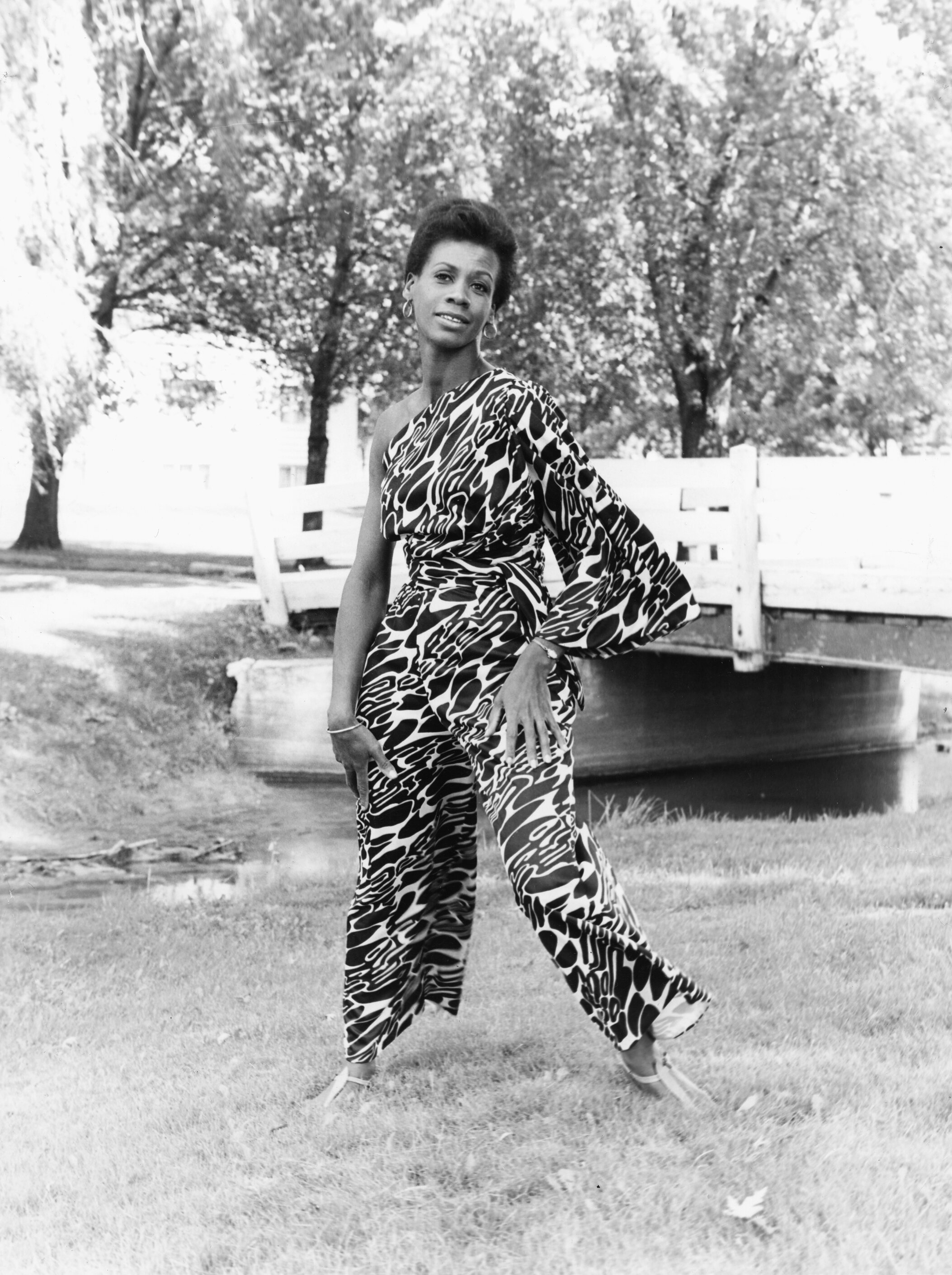
Ola Skanks
Ola Skanks Electronic Archives, Dance Collection Danse.
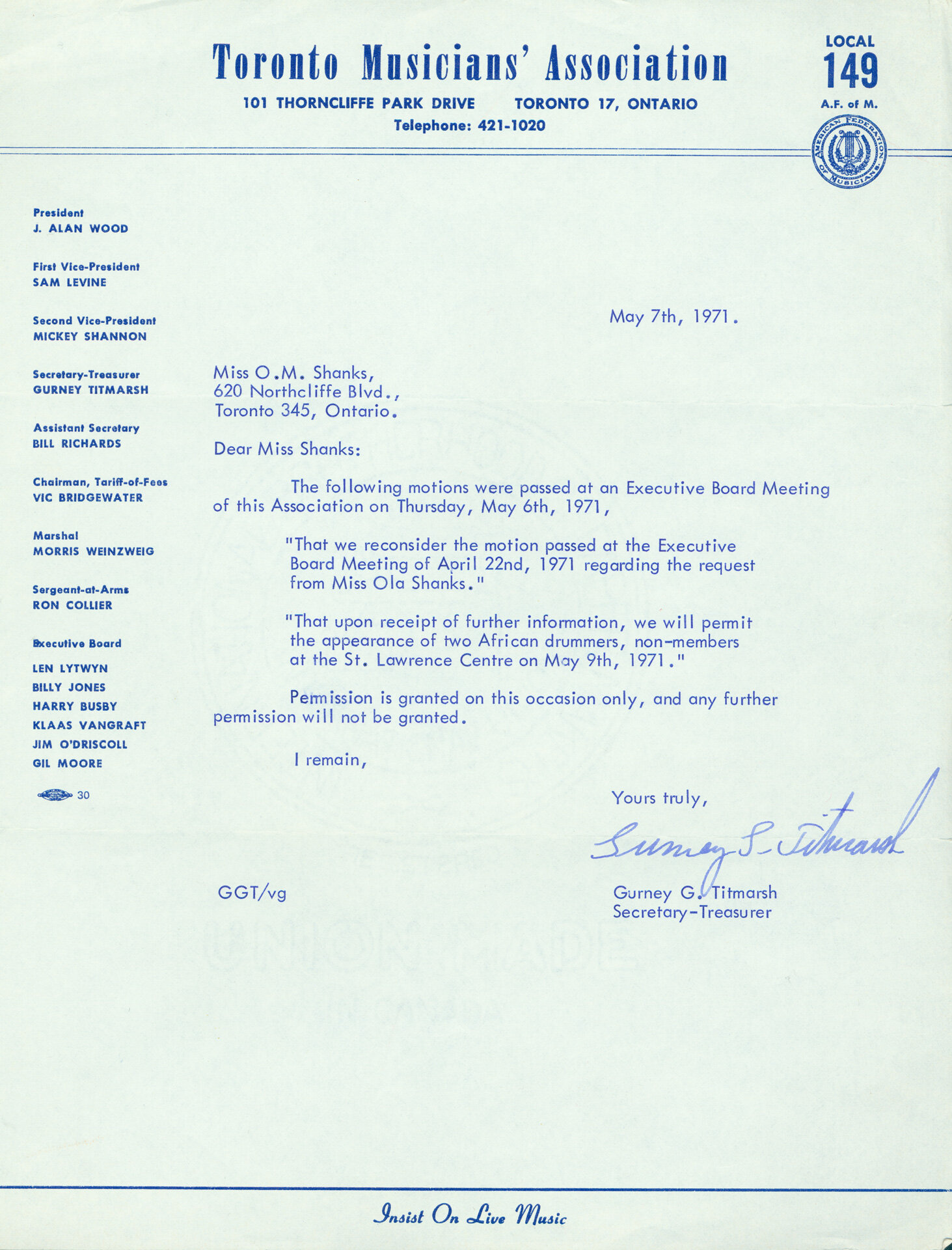
Letter from the Toronto Musicians’ Association, May 7, 1971.
Ola Skanks Electronic Archives, Dance Collection Danse.
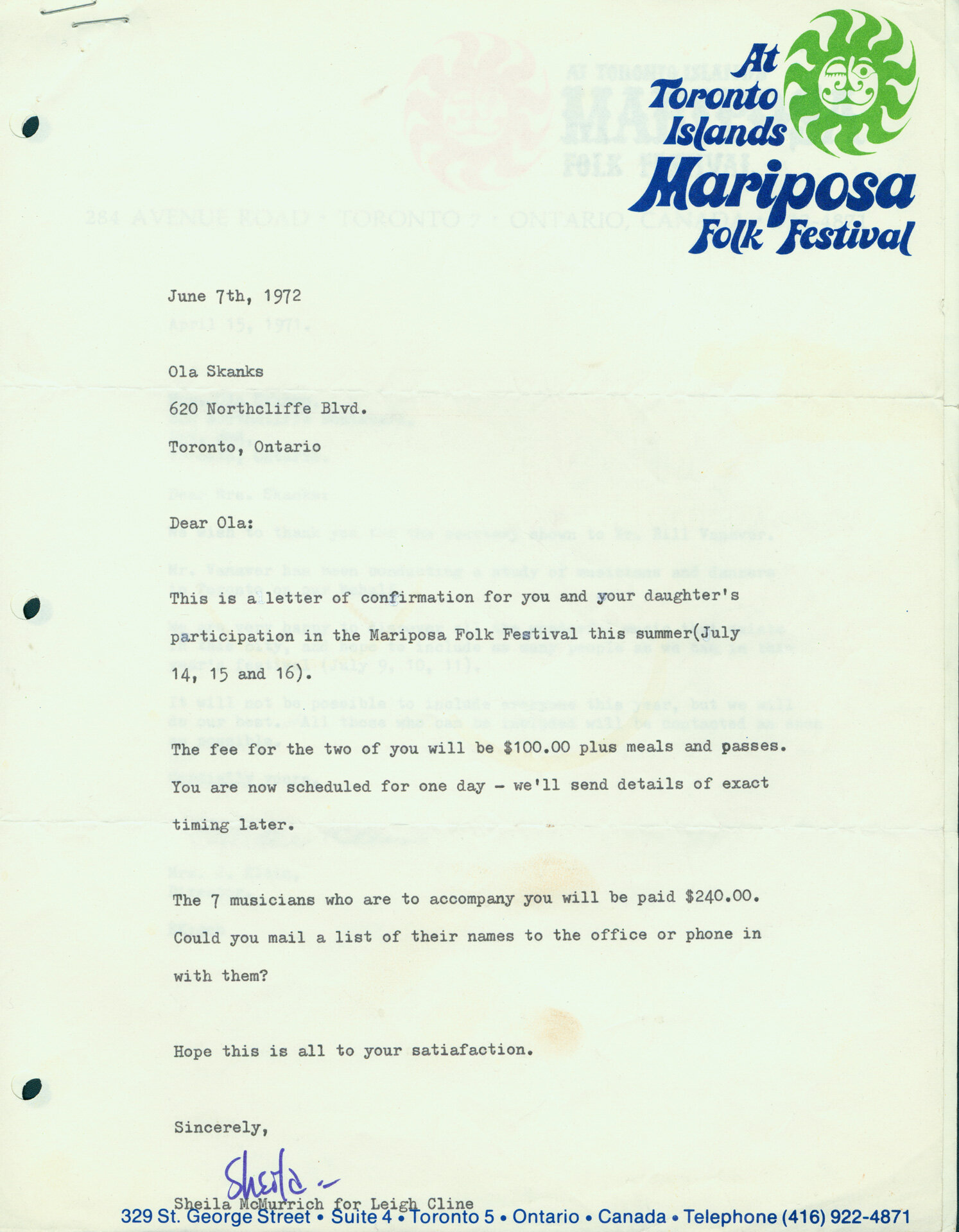
Letter from the Mariposa Folk Festival, June 7, 1972.
Ola Skanks Electronic Archives, Dance Collection Danse.
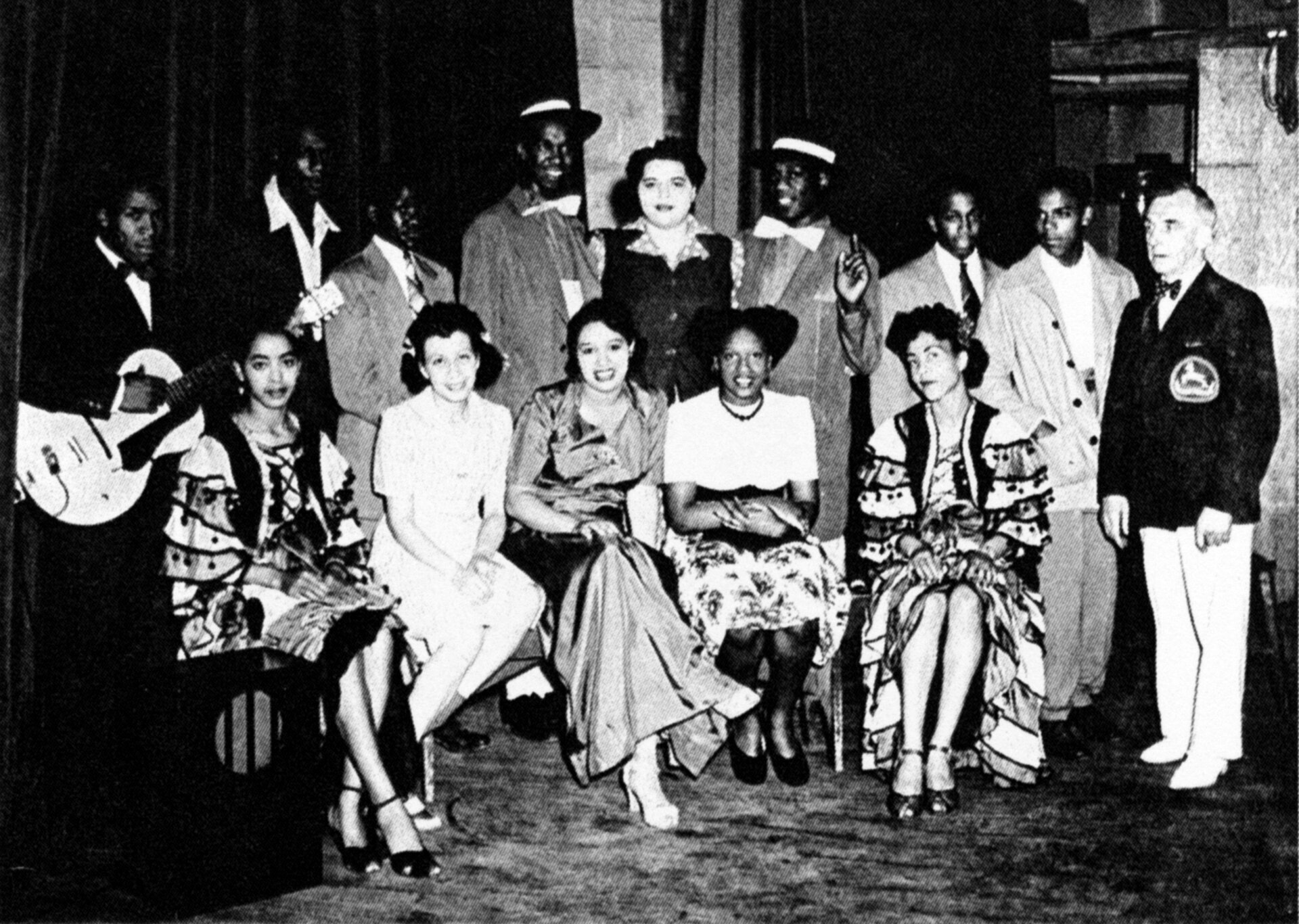
Mr Leonard’s Troupe
Mr. Leonard’s Troupe. Reproduction of a detail from the catalogue for “Syncopated: Black Stories –A photo exhibit" by Archie Alleyne and the Archie Alleyne Scholarship Fund.
The catalogue states: “The revue consisted of young entertainers selected from organizations throughout Toronto, including the UNIA [Universal Negro Improvement Association] Hall, St. Christopher Settlement House, Home Service Assoc-iation and Club Savoy. The 13 entertainers performed for military person-nel stationed on armed forces bases throughout Ontario in the final years of World War II.”
This image is an example of an excellent source for future research. What questions arise when you look at this photo? What dance forms, cultural practices and trends, performance styles or hierarchal structures are visible here?

Joey Hollingsworth on his birthday, c. 1940s, with his parents in London, ON

Ed Sullivan (right) and Joey Hollingsworth (left) during Joey’s appearance on the Ed Sullivan Show in 1962.

Joey Hollingsworth performing with friend and collaborator musician Lenny Breau, c. late-1960s. Photo credit: Wong Quai.

Joey Hollingsworth, c. 1965.

Newspaper clipping focused on the CORE (Congress for Racial Equity) Benefit Concert held at Massey Hall. The article discusses the star power and advocacy behind the US based organization’s benefit concert. The article reports a better than expected turnout despite “‘gloomy predictions”. Hollingsworth was one of the event headliners. Toronto Daily Star, May 25, 1965

Joey Hollingsworth on the cover of his 45 vinyl recording of the songs Little Dandelion and That’s Why I Love You Like I Do, 1966.

Joey Hollingsworth with puppet character King Friday XIII on Mr. Roger’s Neighbourhood. Screen capture from the episode titled “Joey Hollingsworth’s Dance Recital”, E60, May 10, 1968.

Joey Hollingsworth, c. 1970s.

Joey Hollingsworth with Little Carey, New Orleans, 1984.

Joey Hollingsworth, c. 1970s.

Newspaper clipping of ad for Salome Bey’s Indigo, Toronto, 1984.

Joey Hollingsworth (top right) in Salome Bey’s Indigo, Toronto, 1984.

Joey Hollingsworth in The Hot Mikado, San Jose, 1998.
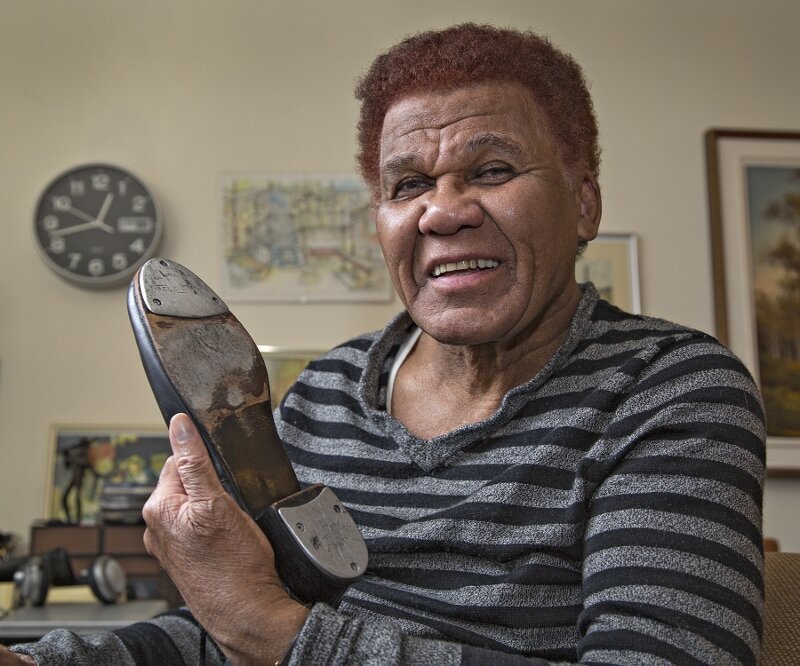
Joey Hollingsworth

Joey Hollingsworth, Defining Movement Dance Studio, Hamilton, 2023.

Public historian Zahra McDoom with Joey Hollingsworth, Hamilton, 2023.





















































































